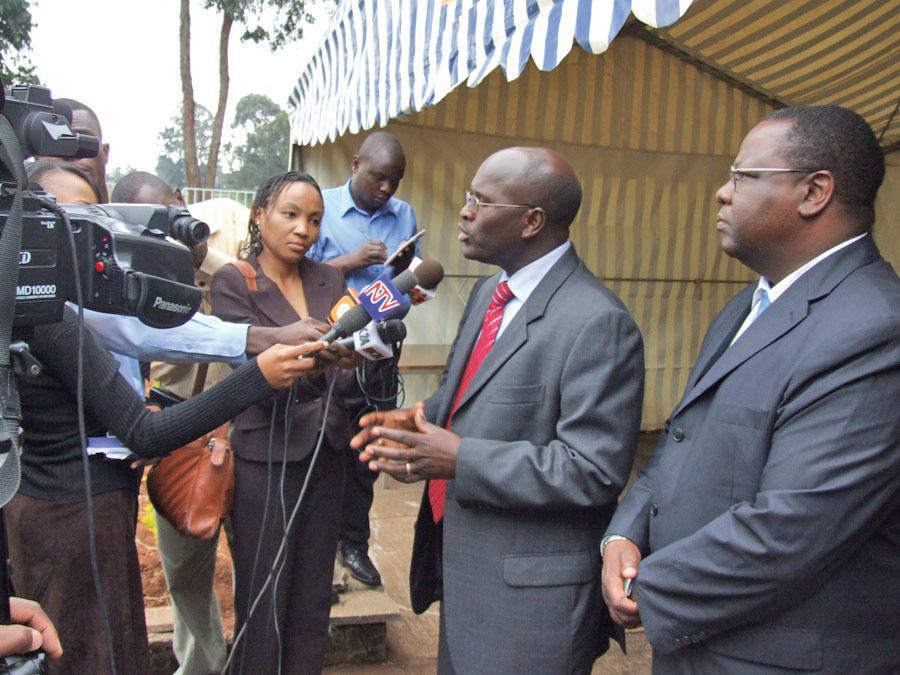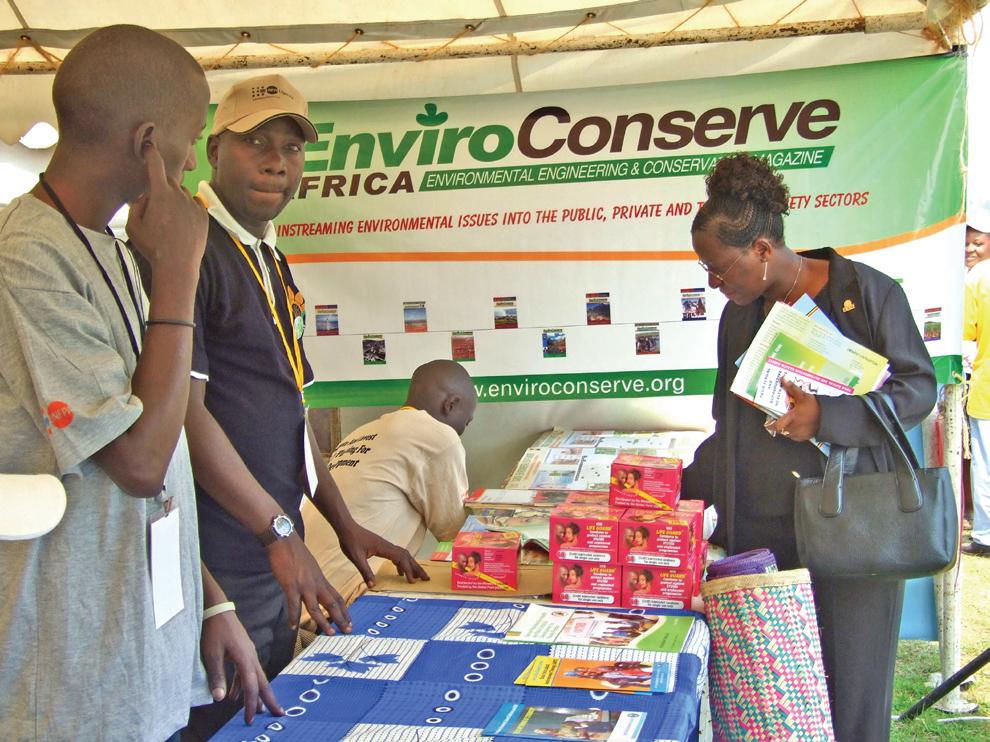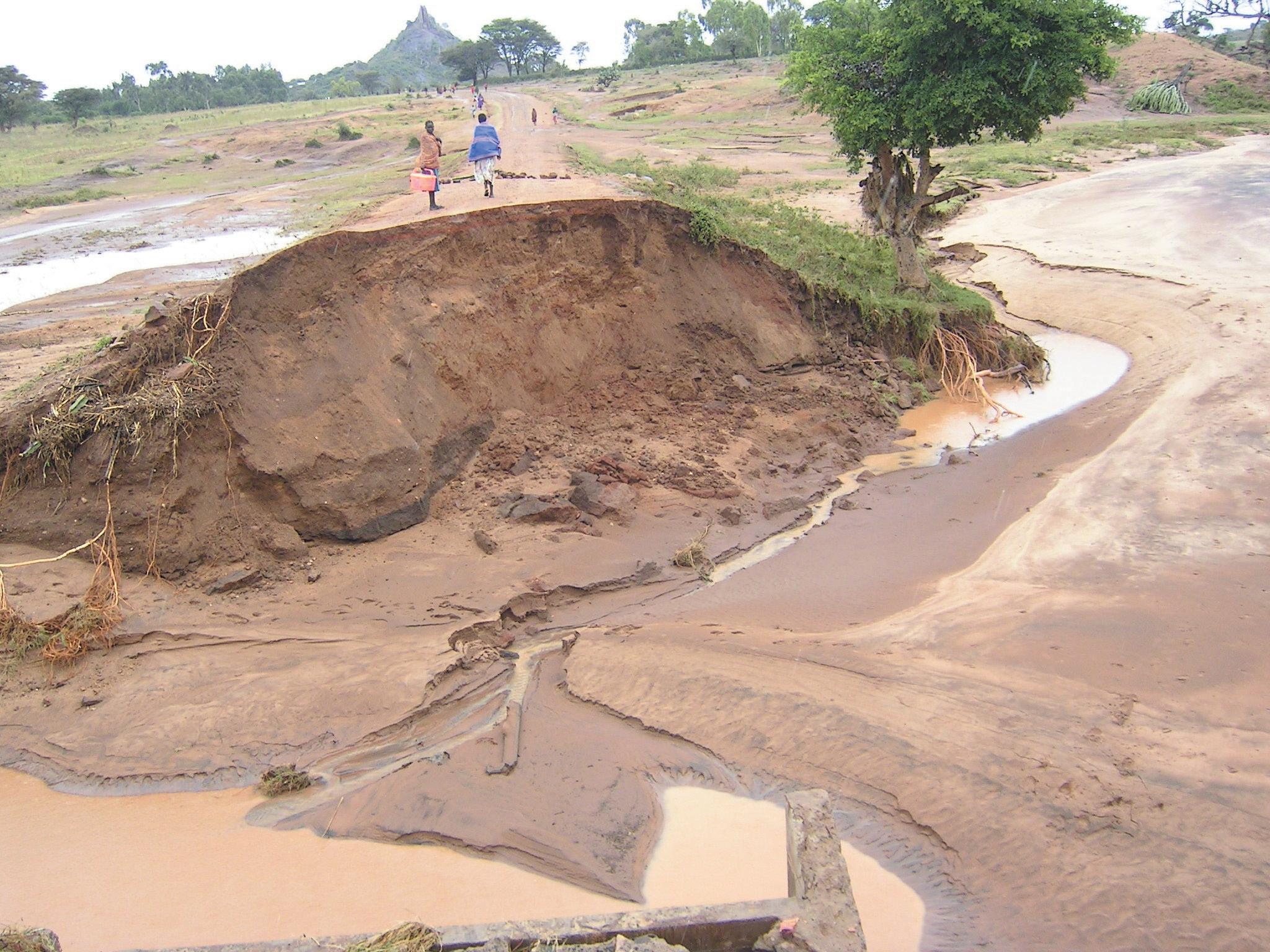
75 minute read
Scientists challenged on GMOs
By Peter Wamboga-Mugirya
Scientists have to take a lead in consuming genetically-modified (GM) crops, to convince the public that such food contains no harm as believed. The Minister for Agriculture, Animal Industry and Fisheries (MAAIF), Eng. Hillary Onek issued the challenge at the National Agricultural Research Laboratories Institute (NARLI) at Kawanda, where GM banana plantlets are growing in a greenhouse and in confined field trials strictly under research. “You have to lead by example and consume these crops when they mature and bear fruits, so that the rest of us can have confidence.
Advertisement
When you do this, you will have totally dispelled fears and doomsday speculators, who claim GM foods are harmful,” Onek said shortly after he officially commissioned the UShs 800m state-of-the-art Biosafety Level II Greenhouse at the NARLI.
It is funded by the United States Agency for International Development (USAID) through the Agricultural Biotechnology Support Project (ABSP II) which is managed by the US-based Cornell University [College of Agriculture and Life Sciences].
Dr Andrew Kiggundu, one of the leading molecular scientists heading the National Agricultural Biotechnology Centre (NABC), and Dr Tilahun Zeweldu [East African Regional Advisor to ABSP II) told the guests who included NARO Director-General Dr Denis Kyetere, that during research work, scientists ensure there is no toxicity or harmful matter in the genes they insert during genetic engineering. “After we have engineered a plant, we continuously carry out tests on it as it grows, to gauge toxicity levels that are tolerable for human consumption when it finally yields fruits,” Kiggundu said pointing at the healthylooking plants.
The Minister, however hailed Dr Andrew Kiggundu and his colleagues (among them Dr. Geoffrey Arinaitwe, Dr Josephine Namaganda, Dr. Leena Tripathi and Dr Wilberforce Tushemereirwe) for the impressive research work on the banana using biotechnology and conventional means to fight the crop’s destructive pests and diseases. Uganda produces 15 per cent of the world’s bananas/plantains and 7million Ugandans consider banana a staple crop, including 65 per cent of the urban population. 75 per cent of Ugandan farmers grow the crop on 1.3 million hectares
Rural Electrification Agency Promotes Environmentally Friendly Electrification
The Rural Electrification Agency started its operations in 2003 having been established by Statutory Instrument No. 75 of 2001.
Vision:
REA’s vision is “Universal access to electricity by 2035”
Mission:
REA’s mission is “To facilitate the provision of electricity for social – economic rural transformation in an equitable and sustainable manner”.
Goal:
Our medium term goal is to achieve 10% rural electrification by 2012.
Objectives
The main objectives of REA include among others: • To facilitate and manage the realization of at 10% rural electrification by 2012. • Undertake the basic planning and preparation of projects determined by the Board as eligible for support under the Rural Electrification Fund (REF). • Generate and provide information relating to investment opportunities, costs and benefits of renewable energy and rural electrification projects and avail technical and financial support programmes to all stakeholders. • Undertake government priority rural electrification projects. • Prepare annual status reports on the rural electrification programme indicating progress and identifying obstacles as well as options for mitigating those obstacles.
Environmental Management
The Rural Electrification Agency has developed an Environment and Social Management Framework (ESMF) field manual that provides the necessary direction for addressing environmental requirements to all stakeholders involved in any project. All projects must comply with environmental and social policies of the Government of Uganda and/or the donor agencies. The projects undergo an environmental impact assessment in accordance with the requirements of National Environment Management Authority (NEMA).
With the ESMF, REA has a monitoring process to observe and check the progress, quality and/or performance against given impact.
Aware of the causes of global warming and climate change, the Rural Electrification Agency advances the following renewable energy technologies that have much lower environmental impact than the conventional energy technologies. These are:1) Hydropower 2) Biomass 3) Solar energy 4) Biofuels 5) Geothermal
Plot 1 Pilkington Road, 10th floor, Workers House. P.O. Box 7317 Kampala, Uganda. Tel: 256-312-264095, Fax: 256-41-346013, E-mail: rea@rea.or.og, Website: www.rea.or.ug
Ministry of Education and Sports
Background:
In 1987, the Ministry of Education, appointed a review commission to inquire into the policies governing education in Uganda. One of the major problems confronting Uganda’s education system was the curricula not catering for the social and economic needs of the country.
The Government’s response to the Review Commission, in its white paper, contained the broad aims of the new policy on education among which was the need to, “eradicate illiteracy and to equip the individual with basic skills and knowledge to exploit the environment for self development as well as natural development for better health, nutrition and family life and capability for continued learning.”
The Ministry of Education and Sports is the lead agency for Environmental Education and Awareness in schools in Uganda according to the National Environment Management Authority (NEMA) statute (1995). In this responsibility, it is supposed to integrate environment issues and concerns in the education system which includes curricula review at all the education levels.
All curricula and the subjects taught in schools have a direct linkage to the environment but the way in which the teachers handle the teaching does not relate the students to understand the concept of the Environment. All science subjects are based on the scientific explanations of the earth systems but the teaching in schools is just too theoretical that of the relationship between education and the environment is not brought out very clearly.
Environment Issues in Education Sector
The education sector is among the largest sectors in the country with a variety of environmental problems mostly associated with schools. The sector is rapidly expanding without considering the quality of environment around them and the future problems associated. The population of students has increased inspite of limited facilities available. This has created a number of environmental problems such as: • Poor disposal of solid and liquid waste; • Poor chemical disposal especially from the laboratories, • Deterioration of sanitation and hygiene because of overcrowding in limited space. • Emergency diseases associated with bad environment. • Indoor Air Pollution (IAP) as a result of using fuel wood for cooking, • Collapsing of buildings causing death to the children due to poor construction works. • Climate change because of excessive dependence or use of fuel wood, emission of gasses from laboratories i.e CFC, burning of polythen papers etc.
All these problems could be overcome if there is a proper environmental awareness among the education providers and the students.
National Environment Problems
The current environment problems in the country are partly due to lack of proper environmental education and awareness programmes in schools. Schools provide a basis for people to acquire skills, knowledge and attitudes necessary to make independent decisions on matters concerning environment. The rampant environment destruction i.e. soil degradation, loss of biological diversity, deforestation, bad farming practices, draining of swamps, poor hygiene in communities is a clear indication of lack of environmental education awareness programmes in school. If the current young generation is given sound environmental education, the future will be different.
Environment Laws and Regulations
Uganda has a number of bilateral agreements and national laws to regulate the use of the environment resourses but few of these are known to the public. Many people have fallen victim to the regulations especially evicting them from gazetted areas like wetlands, national parks, forests because of lack of clear understanding why they should not be in those places. A sound education system enable the people to acquire a clear understanding of the government laws and regulation partaining to environment protection and also perticipate in enforcing them.
The Ministry of Education and Sports is in the process of mainstreaming environment issues in the education sub sectors i.e. departments institutions
Ministry of Education and Sports Ministry of Education and Sports
Environmental Education and Awareness (EEA) in the Education Sector Environmental Education and Awareness (EEA) in the Education Sector
autonomous bodies. This will help the Ministry to monitor the environment issues in a wider perspective than the current situation. It will involve developing policies in relation to environment problems the sector faces
The Ministry of Education and Sports is collaborating with various NGOs and Government Organizations in handling Environmental Education (EE) in schools. The mainstreaming of EE in the Education sector will help to strengthen this relationship. The intervention must involve registering the organizations and knowing what they are doing in schools. Some of these programmes shall be replicated in other schools in the country if they are to contribute to national development.
Environmental Education
Environmental Education is the process of learning and teaching knowledge and skills which enable us to understand and appreciate our surroundings and the interrelationship between us, culture and resources.
Environmental Education’s main objective is to produce people who are sensitive, practical and who are prepared to act for the environment. People should be provided with appropriate knowledge and skills which will enable them appreciate, value and sustainably manage their environment.
Although environmental education is a relatively recent area of training, various aspects of environmental education have always been covered in many formal and non-formal training programmes for a long time. Early environmental education training programmes involved people teaching their youth how to interact with the environment. The programmes were preserved and passed on through folklore and oral literature. The need largely arose from the generally hostile environment within which people had to subsist in early days.
Goals of Environment education
• To foster clear awareness of, and concern about economic, social, political and ecological interdependence in urban and rural areas. • To provide every person with opportunities to acquire the knowledge, values, attitudes, commitment and skills needed to protect and improve the environment. • To create new patterns of behaviour of individuals, groups and society as a whole towards the environment.
Objectives
The key objectives of EE are therefore to:
• Create awareness; to enable social groups and individuals acquire an awareness and sensitivity to the total environment and its allied problems. • Impart knowledge; to enable social groups and individuals gain a variety of experiences in, and acquire a basic understanding of the environment and its associated problems. • Acquire attitudes; to enable social groups and individuals acquire a set of values and feelings of concern for the environment and motivation for actively participating in environmental improvement and protection. • Impart skills; to enable social groups and individuals acquire the skills for identifying and solving environmental problems. • Participation; to enable social groups and individuals with an opportunity to be actively involved at all levels in working towards resolution of environmental problems.
Guiding Principles of EEA
• Consider the environment in its totalitynatural and built, technological and social (economic, political, culturalhistorical, moral, and aesthetic). • Be a continuous lifelong process, beginning at the pre-school level and continuing through all formal and non-formal levels. • Be inter-disciplinary in its approach, drawing on the specific content of each discipline in making possible a holistic and balanced perspective. • Examine the major environmental issues local, national, regional and international points of view so that students receive insight into environmental conditions in other geographical areas. • Focus on current and potential environmental situations, while taking into account the historical perspective. • Promote the values of local, national and international co-operation in the prevention and solution of environmental problems. • Explicitly consider environmental aspects for development and growth. • Enable the learners to have a role in planning their learning experience and provide an opportunity for making decisions and accepting their consequences. • Relate environmental sensitivity, knowledge, problem-solving skills and value clarification to every age, but with special emphasis on environmental sensitivity to the learner’s own community in formative years. • Help the learner discover the symptoms and real causes of environmental problems. • Emphasize complexity of environmental problems and thus the need to develop critical thinking and problem-solving skills. • Utilize diverse learning environment and broad learning about, and from the environment activities and firsthand experience.
Kenya starts e-waste management project
By Obadiah Ayoti
Computer for Schools public against pollution from waste, Kenya (CFSK) has little is mentioned about e-waste. The launched an ambitious subsidiary legislation under Environmental e-waste management Management and Coordination Act project as part of its environmental (EMCA) puts more emphasis on solid conservation efforts. waste management to which even it falls
The plant which was set up at a short on implementationCFSK which is a cost of KSh3.8 million was unveiled Non Governmental Organization (NGO) recently by the Ministry of Information and provides computers to learning and Communications’ Permanent institutions free of charge launched the Secretary, Dr. Bitange Ndemo to programme to ensure the computers are provide an opportunity for corporate not dumped in a manner that can harm organizations to dispose their human beings or the environment. With electronic waste in an environmentally the technology storm, the tonnes of e-waste friendly manner. generated from industries, organizations
The project situated at Nairobi’s and homes pose a great danger to the Embakasi area was funded by Kenya biodiversity. Airways, Safaricom Foundation, Additionally, the ongoing laying of fibre Unilever, Computer Aid International, optic cable in Kenya is set to drastically Barclays Bank, IDRC and the reduce the cost communication for majority Government of Canada. CFSK of people to afford. This calls for initiatives Executive Director Tom Musili told such as the CFSK to mitigate electronic EnviroConserve that there was need waste which is more dangerous than solid for the government to establish an waste as it causes chronic diseases such e-waste policy in order to protect the as cancer. environment. Although CFSK has been recycling old “It is a shame that a country such computers since its inception in 2002, as Kenya which is a signatory to a their facilities were overwhelmed after plethora of international conventions on environment doesn’t have an electronic waste policy. There are no strategies to guide us in handling waste management of this nature. We are forced to use our initiatives and borrow examples from other countries,” says Musili. Despite collaboration with the Ministry of Environment and signing of a Memorandum of Cooperation with the National Environmental Management Authority (NEMA), the Executive Director faults the organizations’ commitment towards e-waste management. In NEMA’s waste management regulations of 2006 meant to protect the environment and the corporate organizations embraced their ‘No Dumping’ policy and started giving them electronic waste for proper disposal. Currently, Barclays Bank, Joint Voluntary Agency (JVA), KPMG, Dell of South Africa are some of the organizations sending their old computers, mobile phones, televisions, radios, printers, faxes, photocopiers and other types of e-waste to CFSK for recycling. In a classic example of turning waste to wealth, the computers are dismantled into metals, wires, plastic, aluminium, copper, monitors and electronic boards which are then sold separately to fetch funds to cater for the organization’s operation cost. “We sell metals, aluminium and wires to Nairobi Metal Dealers. For those parts such as electronic boards which cannot be recycled in Kenya, we have a take-back policy with one of our donors, Digital Links in the United Kingdom where we send them back for recycling,” said Musili. In another venture where the organization literally turns waste into gold, it converts the monitors into television sets by replacing its boards with those of televisions. The television sets are then sold at a cost ranging from Ksh 4, 000 to Ksh7, 000 depending on the size. CFSK receives computers from Christian Hunger Relief, Computer Aid International, Siso, Afritec and Partners Worldwide. The computers must meet certain standards set by CFSK to ensure that developed countries do not use Kenya as a dumpsite. CFSK plans to mobilize resources to purchase recycling equipment so that they do not export some equipment for recycling abroad
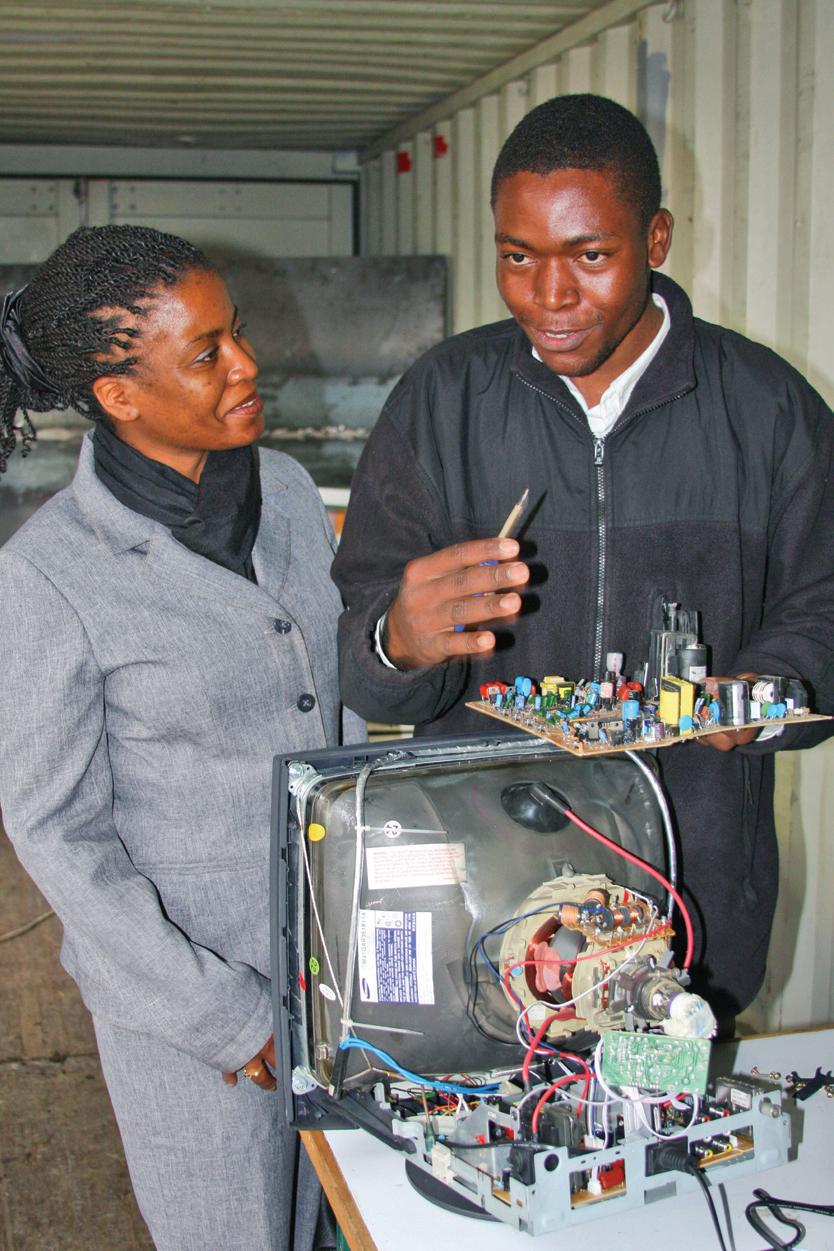
CFSK technician Boniface Asuva (r) takes through Susan Akwesi, Kenya Airways Regional Cargo Sales Manager for West, Central and North Africa the process of converting old computer monitors into television sets.
Tree planting campaign kicks off
National exercise launched on Youth Day
H.E Yoweri Kaguta Museveni (file photo)
By Ronald Musoke
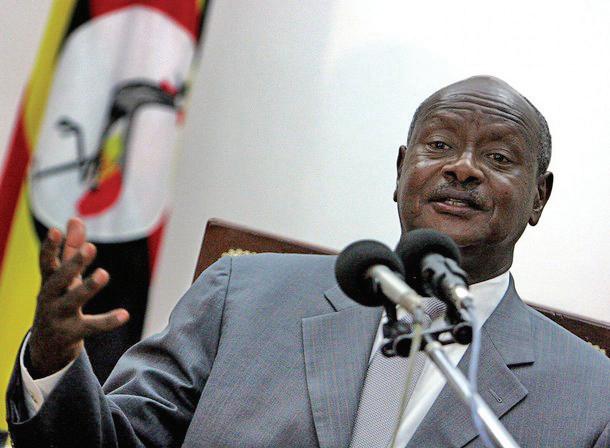
The long-awaited nationwide tree planting campaign was finally launched on August 12, during the International Youth Day celebrations at Karwondo village in Rwanyamahembe Sub County in Mbarara District under the auspices of the Ministry of Water and Environment.
International Youth Day, alongside International Women’s Day (March 8), World Forestry Day (March 21), International Labour Day (May 1) will henceforth become official tree planting days. On each of these days, the youth, women, workers and other stakeholders will respectively be required to plant as many trees as they can through several government and private initiatives.
A total of 35,300 tree seedlings were distributed by the ministry. In Mbarara District alone, 4000 tree seedlings were planted. The trees that comprised pines, eucalyptus and fruit trees were freely given out to residents of the sub county.
The districts of Gulu, Lira, Soroti and Kitgum were each given a consignment of 8000 tree seedlings so they could utilize the good rains they are currently enjoying. Bushenyi and Kabale will also be receiving their tree seedlings shortly.
According to the Environment state minister Jessica Eriyo, the government chose this day to start a nationwide tree planting campaign to curtail the rampaging desert conditions that are said to be heading southwards. “The issue of planting trees is very important and it rhymes well with today’s theme since 20 per cent of global warming is contributed to by deforestation and wetland loss.” Ms Eriyo said. Researchers on climate change have claimed that due to the poor adaptability levels among the poor people and countries, the poor will suffer more. In recent years, climate change has increased storms, floods, soil erosion, extinction of plants and animals, water stress and tropical diseases around the world.
“As for our country [Uganda], we should concentrate on mitigation efforts such as control of greenhouse gases, floods, soil erosion and siltation of water bodies. Planting trees is the most important way we can do to mitigate climate change,” she said.
The day’s theme, “Youth and Climate Change: Time for Action,” was chosen to enable the youth and indeed Ugandans in general to take stock of what they have done to green the environment and control the use of ‘buveera’ (polythene bags).
“The unforgettable message is, ‘greening the environment is everybody’s responsibility.’ We need to do everything humanily possible to keep Uganda the Pearl of Africa,” Mr. Mondo Kyateeka, the Assistant Commissioner, Youth and Children Affairs said.
He said Uganda’s youth (young people between 18-30 years) constitute six million while those below 18 years are 16 million, making a total of 22m young Ugandans. UNFPA says there are more than 1.5b people between the age of 10 and 25 around the world. “This largest ever generation of adolescents is approaching adulthood in a world their elders could not have imagined,” UNFPA says. “Climate change asks tough questions when it links the present generation actions to those that will come after. Most times when we talk about environment, some people think we are talking about theories but you can see what the vagaries of weather have done to us,” Mondo said. Saida Namirembe Bumba, the Minister of Gender, Labour and Social Development added that this year’s International Youth Day theme was timely and its emphasis has been long overdue. “There is need to institute a culture of valuing our environment,” she said.
The guest of honour, President Yoweri Kaguta Museveni while presiding over the International Youth Day celebrations said there have been two major causes of global warming and climate change.
The president named agents of climate change as the rich industrialised nations of Europe, North America, as well as China and to some extent India which release millions of tonnes of greenhouse gases to the Earth’s atmosphere every year, and pollution brought about by poverty in the third world countries.
“When the poor use firewood, instead of electricity, engage in traditional agriculture, they are engaging in environmental degradation,” Museveni said.
Museveni said the solutions to climate change lie in engaging the industrialised nations such as USA to ratify the Kyoto Protocol and most importantly bringing development to the third world, especially Africa. “That’s why the NRM government is busy building dams so that we can make use of electricity. This will preserve our trees,” he said in his address of the youth who listened attentively.
He added that government is working on another programme which involves the transformation of agriculture in the country through the Plan for Modernization of Agriculture (PMA) and the National Agriculture Advisory Services (NAADS) programmes.
“These programmes will not only conserve the environment but also improve our incomes through improved agriculture production techniques,” Museveni said.
The president reiterated his ‘prosperity for all’ message, adding that soon the NAADS programme will look out for six model families in each of the 5000 parishes around the country from whom the other families will learn about better farming techniques. He said if this programme is well adopted, an average Ugandan family would make about Ushs 20m every year
Oil production site irks conservationists

Hon Maria Mutagamba (with head gear) the minister of water and environment was part of the field trip that Tullow Oil organised for participants of the EPS public hearing (courtesy photo)
Discontent over Tullow Oil’s location of Early Production Scheme site
By Ronald Musoke
Leading conservationists in the country recently expressed outrage at Tullow Oil’s request to have the Early Production Scheme established in an area that is gazetted as a wildlife reserve.
This was during the recent National Environment Management Authority (NEMA)’s public hearing of Tullow Oil’s Environment Impact Assessment for the proposed Early Production Scheme (EPS) in Block 2’s Kaiso Tonya region situated in the western Uganda district of Hoima.
NEMA as well as the Ministry of Energy and Mineral Development alongside other stakeholders called for the public hearing on July 29 at Hoima’s Hotel Riviera.
Public hearings are carried out in accordance with Section 22 of the environmental impact assessment regulations within the 1998 Environment Act. The developer is required to conduct an environmental impact assessment before their project can be approved by NEMA.
According to NEMA’s executive director, Dr Henry Aryamanya Mugisha, public hearings are conducted to seek additional information which may be lacking in the developer’s Environmental Impact Statement (EIS) so that relevant action may be taken.
The study that started in September last year and submitted in March this year was conducted by two EIA consultant firms, Environmental Resources Management (ERM)-a South African based firm and EACL of Uganda. The need for an early production scheme has been precipitated by the urgent need for electricity, kerosene, and diesel in the country, and if all goes well, the government is targeting between 85-100 megawatts of electricity to be produced using heavy fuel oil (HFO) that will be got when about 4000-5000 barrels of oil are produced on a daily basis, starting next year. “The early production scheme will see the establishment of a mini refinery on a clearing the size of 15 standard football grounds near the Kaiso Tonya Community Wildlife Area. It will have a topping unit where oil will be separated from sand and water,” said Stuart Herbert, ERM’s representative and presenter of the EIS.
Herbert said the EIS recognizes that Kaiso Tonya is an ecologically fragile area with many on going activities that might or will be interfered with. He cited fishing in the nearby Lake Albert, livestock farming and fresh water in the valleys and
underground, rivers, and the lake as well as wood harvesting as some of the activities that will be affected once production starts next year. “Within the Lake Albert Graben, the Semliki River, the Ramsar Wetland near Lake George as well as eco- tourism at the Lake Albert Safari Lodge where some of the local people have jobs are ecologically important,” he said. In his presentation, Herbert noted that the EIA consultants chose Site 1C which is within a wildlife reserve as opposed to Site 5C (area atop the escarpment) due to ‘prevailing constraints on the ground.’
Local Concerns
During the consultations with the local communities, the local people were more concerned about whether there would be disruptions in their livelihoods when the scheme begun. According to ERM, the locals wanted to know whether their water sources will remain safe as far as quality and quantity is concerned. The locals also wondered whether one of their major activities-fishing-would go on without any underground contamination into the rivers and ultimately into the lake.
On biodiversity concerns, Tullow Oil’s EIS noted that during construction of the EPS, ‘some animals may move away from noise and other related activities and that some plants will need to be removed.’ The EIS noted that minimal harm will be ensured so that the area to be negatively affected will be as small as possible. Tullow’s EIS report added that after the construction of the EPS, the areas surrounding the establishment will be restored to their original state. The company pledged to work closely with the Uganda Wildlife Authority and other groups.
On air quality and waste management in the area, Herbert said Tullow Oil had designed the EPS to international standards and that they will continue to monitor the quality of the air in the area. The company’s report said they are working with a reputable company to manage its waste that will be generated at the site.
Responses to Tullow’s EIS
However, there were many concerns about the EIS with many respondents saying the report left a lot to be desired. Mr. Sam Mwanda, representing UWA’s executive director said UWA had serious concerns about the report. “There are big gaps in the report with regard to the waste management plan and environment management plan preparations,” Mwanda said, adding that the report hardly has any specific recommendations for the environmental challenges ahead.
“The lifespan of an EPS is estimated at 15-20 years but tourism has the potential to continue for hundreds of years. There is need therefore for the developer to enter into a compensation agreement with UWA and other stakeholders to compensate them for the lost income and be able to support conservation in the area,” Mwanda said.
UWA further noted that there is a huge potential for pollution yet the EIS does not put particular emphasis on this challenge. The wildlife conservation body also noted that monitoring and compliance should be a big issue, yet Tullow and NEMA have been short on the monitoring during the exploration stage. UWA also pointed out the potential risk of pollution of the water sources such as the River Howa valley/ water for the wildlife especially during the dry season. According to UWA, this river also drains into Lake Albert and therefore this development will have a bearing on the water resource for fishing and domestic use by the fishing community as well as affecting the water cycle in the area.
UWA recommended the establishment of a conservation fund to ensure sustainability of the conservation activities in areas where oil exploration and development is taking place. “Specifically, the funds should be used to supplement the dropped revenue from tourism as a result of oil development, create corridors for animal movement through direct land purchase, create buffer zones as dispersal areas for wildlife in light of the oil development activities,” noted UWA.
John Ken Lukyamuzi, a renowned environmentalist and also the president of the Conservative Party noted that as far as he had listened (to EIS presentation), the key issues in the report seemed to be ‘promissory’ and he wondered what guarantee Ugandans have that Tullow will fulfill the promises they were making. On biodiversity in the area proposed for the EPS, he said Uganda and Namibia are among the richest countries in biodiversity related to birds. “Around Lake Albert, over 400 bird species have been spotted and in Kabwoya Wildlife Reserve, over 460 species live there, Tullow Oil intends to construct the oil refinery. The refinery site must change,” he said
TANZANIA
Building of phone masts suspended
Tanzania’s National Environment Management Council (NEMC) has called for suspension of ongoing construction of telecommunication towers which lack in-depth research on health risks they pose to people and the environment. The mobile phone companies should also draw defensive mechanisms in case of accidents as the law requires.
Speaking during a press conference in Dar es Salaam on August 18, NEMC Director General Bonaventure Baya said the mushrooming of the towers in the country, has sparked fears and complaints over dangerous effects to both humans and the environment. The council has urged mobile phone companies to conduct research on effects of telecommunication towers before they erect them in residential areas. Mr. Baya said telecommunication companies have to involve people and local government authorities in the ordered research on the towers and findings be forwarded to NEMC in order to clear people’s doubts.
Mr. Baya added that since December 2007 to date, NEMC had received several complaints from Tabata Kimanga on Tigo towers, Msasani against Excellent Communications, Kimara Baruti against Celtel (now Zain), Kimara against Vodacom, Kijitonyama against Tigo and Magomeni against Celtel. This comes amid complaints from the public living near phone towers that they are dangerous as they produce radio active rays which can cause serious diseases like cancer, and noise they produce as a result of their generators operating for 24 hours.
“The complaints are results of unplanned erection of phone towers which has become a source of disturbance and rising fears by people,” said Mr. Baya, calling on the phone companies to adhere to laws of the land. The council has since suspended construction of a tower at Msasani Peninsula in the city by Excellent Com to pave way for investigations on the legality of the company to construct a tower there, added Mr. Baya ■
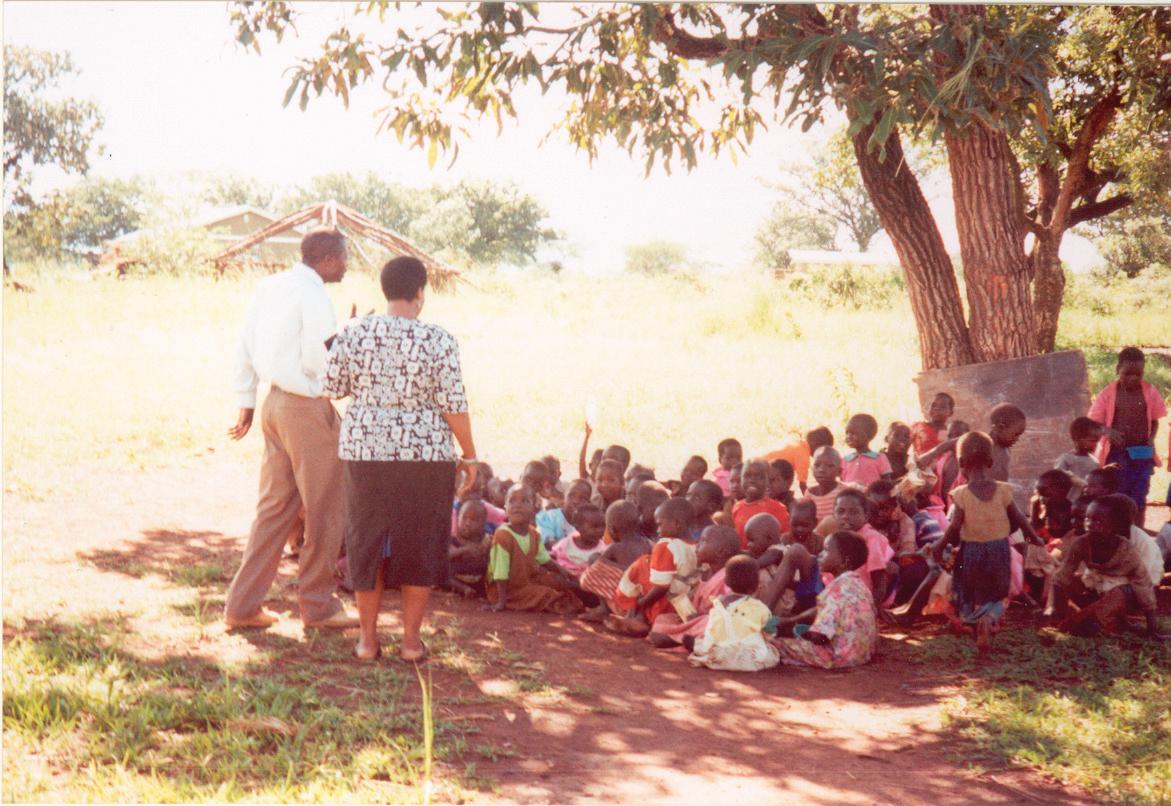
BACKGROUND:
The Directorate of Education Standards (DES) formerly known as Education Standards Agency (ESA) was established in July 2001.Its mandate is to maintain qualitative academic and disciplinary standards in the education sector and institutions of Uganda. This mandate emanated from the Education Act, followed by the Cabinet’s decision on Divesture that authorized the Minister of Education and Sports to set up a separate (semi-autonomous) body to replace the Education Inspectorate.
Since its establishment, DES has operated guided by the recommendations of the ESA Report of June 2000 and the Policy Guidelines and Implementation Strategy document provided by the Ministry of Public Service (March 2001). The ESA report was approved by top management of the Ministry of Education and Sports while the Executive Agency Implementation Programme (Policy Guidelines and Implementation Strategy) was approved by Cabinet. goals, relevant to the needs, rights and expectations of its learners, the community and society at large.
To address quality education holistically in terms of provision, implementation and continuous improvement requires consideration of the following: inputs, processes, outputs and outcomes.
• Inputs or resources applied to the education system. These include the learners, teachers, buildings, instructional materials and the curriculum. If any of these inputs is defective, appropriate or inadequate, the quality of education will be affected. • The processes refer mainly to the teaching/learning, management and governance. These processes will influence the learner/teacher interaction, the learning environment, utilization of the learning materials, motivation and competency of the teachers and the creation of school
DES MISSION
To provide a rational system of setting, defining and reviewing standards and quality of education and sports and to monitor the achievement of such standards and quality to ensure continually improved education and sports in Uganda.
DES MANDATE
The Directorate of Education Standards (DES) is mandated to ensure maintenance of qualitative academic and disciplinary sports standards in the education sector and institutions of Uganda.
Quality education enhances the potential and promotes the full development of the learners in terms of knowledge, values, skills and attitudes. A quality education is widely accepted as one that is accessible to all, efficient in its use of available resources, effective in meeting locally and nationally agreed
DIRECTORATE OF EDUCATION STANDARDS DIRECTORATE OF EDUCATION STANDARDS Population and Quality Education Population and Quality Education
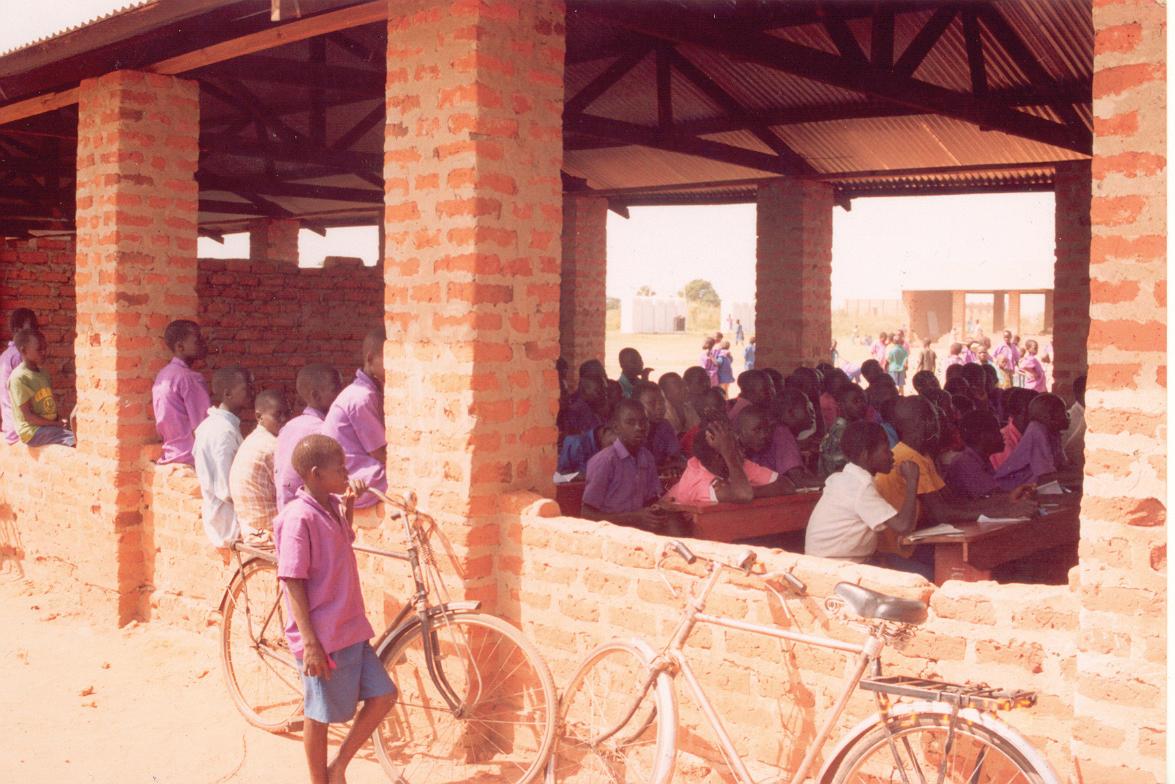

ethos and culture. • Outputs refer to the immediate results of the education processes.
They can be measured in terms of examination results and music, dance, drama and sports achievement. • Outcomes of the education system refer to the longer term benefitsto the learner and the community. They are reflectedintheperformance and advancements in employment, health, environment, social justice, economic development and democratic systems in society.
Achievement of quality education is affected by a number of factors including demography, economy, political environment and social development. For example the 2002 national housing and population census revealed that more than one million children were less than one year old. Subsequent population reviews show that the population is growing at a rate of 3.4% per year. If such population growth is not balanced with economic and social development, the quality of education provided will be negatively affected.
When government launched the Universal Primary Education (UPE) in 1997, the primary school enrolment increased from 2.4 million in 1996 to about 7 million. However, other inputs like infrastructure, the instructional materials and teacher recruitment did not grow over night to the same extent although they have increased over the years. This affected and to some extent still affects the quality of education provision.
CHALLENGES TO QUALITY EDUCATION
• Class size is too large ranging from 60 learners and above in both
primary and secondary in each stream. • Inadequate teachers and lack of accommodation in most schools • Inadequate supervision by school administrators and inspectors. • Inadequate and inappropriate infrastructure (classrooms, sanitation facilities), instructional materials and other facilities. • Lack of mid-day meals for learners and teachers.
WAY FORWARD
All stakeholders including the government, parents, local leaders, District Education Departments, proprietors, administrators, teachers, learners and society in general should make their due contributions to ensure quality education. there is also urgent need for family planning programmes.
Ewaso Nyiro River, one of the rivers drying up due to Mau Forest encroachments
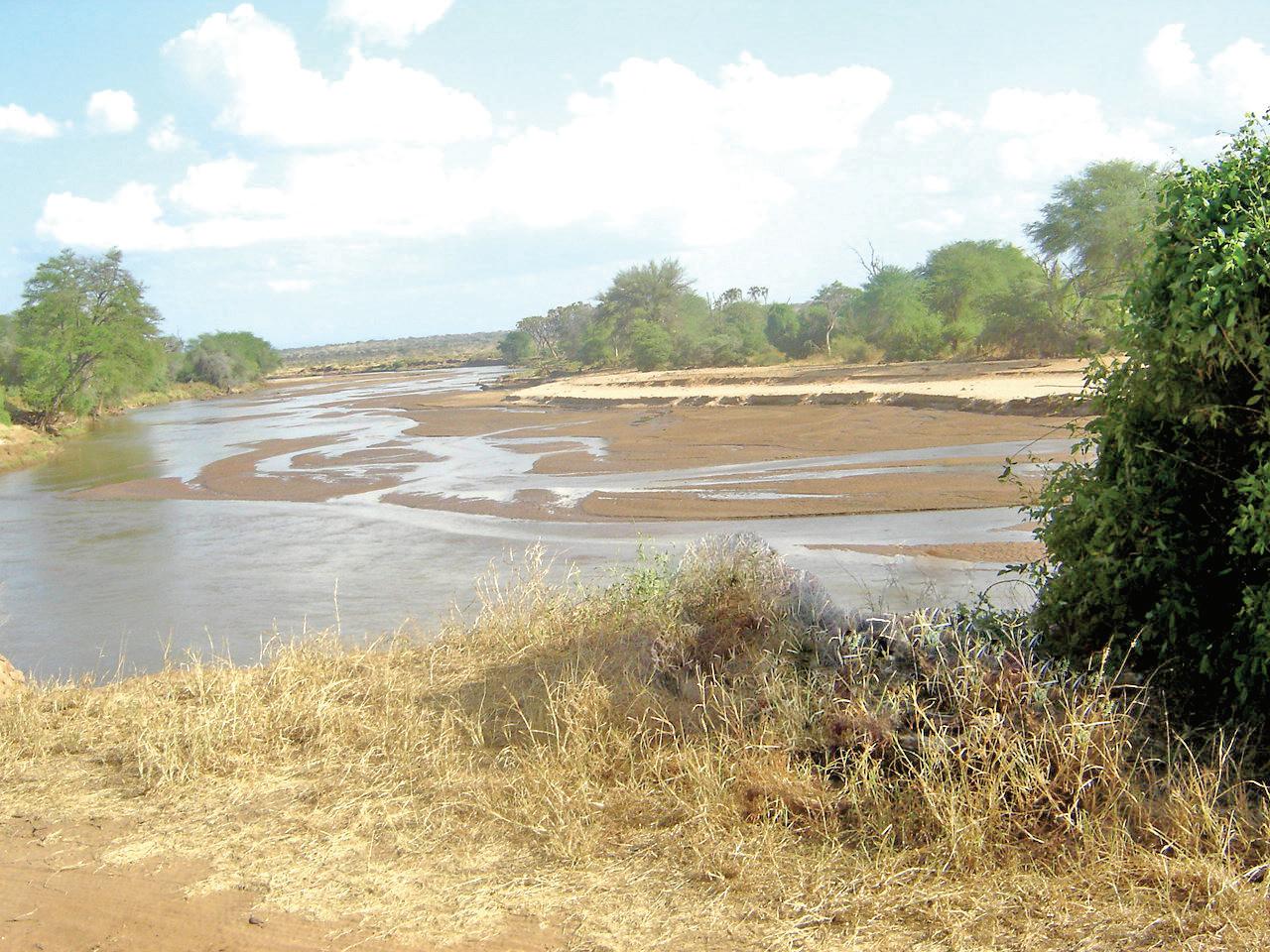
Saving Mau Forest
Alarmed at the rate of destruction of one of its most important ecosystems, the Kenya government has taken urgent steps to stop further destruction of Mau forest
By Obadiah Ayoti and David Matende
After years of continued destruction of its unique forests, Kenya is now feeling the pinch. Rainfall has become unpredictable, leading to reduced water in the country’s main rivers and lakes. Scarcity of water in the urban centres has become the order of the day.
Agriculture has been adversely affected, increasing food insecurity. The country’s sources of hydro-power have been depleted, occasioning a massive increase in the cost of electricity. There is increased humanwildlife conflict as the animals find themselves squeezed out of their natural habitat. Alarmed at this development, Kenya’s leadership has decided to do something.
Recently, the government demonstrated its commitment to conserve its forests by forming a task force to explore ways of preventing further degradation of one of the country’s (and the world’s) great ecosystems — the Mau forest complex.
The task force inaugurated recently by the Prime Minister, Raila Odinga would demarcate and fence off the 400,000-hectare Mau complex which is one of the five major water towers in the country. The Mau has been a victim of destruction for many years, with past governments allocating huge chunks of forest land to neighbouring communities, mainly to buy their political support.
The Mau ranges form one side of nature’s architectural marvel, the Great Rift Valley.
It is on these ranges that the Mau Forest nests, cuddled by a rare mix of animals, birds and flora to constitute one of the largest water towers in the country.
The forest nestles in a complex ecosystem that is the source of at least 12 rivers, which drain in either direction — westwards towards Lake Victoria and eastwards to Nakuru through Mau Narok, Lake Nakuru and the Mara-Serengeti tourism circuits.
The Mau complex is Kenya’s biggest forest block and East Africa’s largest block of closed canopy indigenous forest.
Viewed from the air, it resembles a lush, green carpet, with some brown patches where illegal logging and charcoal burning takes place, deep in the forest, away from the prying eyes of forest guards and conservationists.
More than 45 bird species and 2,000 families live here. The latter, including logging and charcoal burning, has put to risk an asset base worth more than $300 million (more than Sh20 billion).
That is if the current rate of forest destruction goes on. Tea bushes, tourism and the water catchment are in acute danger.
According to the United Nations Environment Programme, Mau is an asset of national importance that supports crucial sectors such as energy, tourism, agriculture and water supply. It is also the single most important water catchment area in the Rift Valley and Western Kenya.
“For the past few years UNEP has been documenting for the Kenyan Government and
the people of Kenya the continued destruction and erosion of this vital ecosystem. It has reached a point where if no measures are taken, Kenya will lose one of its fundamental assets,” warned Achim Steiner, UN UnderSecretary-General and UNEP Executive Director.
Estimates indicate that up to a quarter of the complex has been destroyed through encroachment, excisions, illegal logging and other human activities.
Since some rivers drain into the Lake Victoria, there is likely to be implications beyond Kenya’s borders all the way into the River Nile basin if they dry up.
Domestic water supply will also be severely aggravated, spelling doom for thousands of people who depend on it. The largest inhabitants of the forest are the Ogiek or Dorobo, who have traditionally been hunter-gatherers and keepers of bees. The activities are now unregulated, thereby directly contradicting forestry and conservation policies.
Some individuals were awarded huge chunks of land as the forest was excised and cleared to pave way for human settlement. Pressure from settling human population added to the problem. Lots of tea was planted, to extend the area under this crop beyond traditional locations such as Molo South, Olenguruone, Chepakundi, Temuyotta, Kenjoketty, Kiptagich and Nyota.
There are five main forest reserves: Eastern, Western and South-western Mau covering 66,000, 22,700 and 84,000 hectares, Trans-Mara (34,400ha) and Ol Pusimoru (17,200ha).
A sixth large block, the Maasai Mau, covering 46,000 hectares, is not a gazetted forest. The Mau has deep, fertile, volcanic soils, and enjoys one of the highest rainfall levels in Kenya. Annual rainfall ranges between 1,000mm to a high of 2,000mm as you move towards the west.
Numerous streams drain the forests west of the sharp crest, forming part of the Sondu and Mara river systems, which flow into Lake Victoria, and the Southern Ewaso Nyiro system, which flows into Lake Natron.
The Eastern Mau is the main watershed for Lake Nakuru, through the Njoro, Makalia and Enderit rivers. The surrounding areas are intensively farmed, with human population about twice as high on the western side of the forest compared to the East. Vegetation patterns are complex with lower montane forest below 2,300m and westwards to thickets of bamboo, which consists of forest and grassland. The southwestern zone is the most affected by illegal logging.
The forest is under trust land, managed by the County Council of Narok, one of the richest local authorities in the country.
Most of the problems may have begun in 1999 when the local authority allowed group ranches, owned by the locals, to be subdivided and sold to members.
To address real issues, a fence is to be erected around the forest, just as in sections of the Aberdare Forest, which have been electric-fenced to stem human-wildlife conflict.
Since the forest is the source of 12 rivers and a lifeline for millions of people, the committee would mobilize resources to restore the complex and establish a special court to prosecute those found involved in irregularities in the forest.
The task force comprises of 21 members drawn from senior officials from relevant ministries, representatives of stakeholders groups and expert organizations including United Nations Environment Programme (UNEP). The prime minister has imposed an embargo on logging and burning of charcoal in order to prevent further destruction of the forest.
“The task force will ensure that no further destruction by felling trees for building and burning of charcoal. Police have been informed and no lorry should be seen carrying trees or charcoal from the forest,” warned Odinga.
He expressed concern over the continued degradation of Mau Complex.
“The excisions and the widespread encroachments have led to the destruction of nearly a quarter of the Mau Complex area over the last 15 years. Such an extensive and on-going destruction of a key natural asset for the country is nothing less than a national emergency,” added the Prime Minister.
The country is feeling economic and environmental pinch of the continued degradation of the great ecosystem through activities such as illegal logging, excisions and encroachments.
Recently the government cancelled the commissioning of the 60MW Sondu Miriu hydroelectricity project because the water levels in the holding dam had drastically reduced. The rationale was that river Sondu that feeds the dam originates from Mau forest which is currently under threat from human activities.
Now the future of the US $185 million hydro power station funded by the Japanese government hangs in the balance at time when the cost of electricity in the country has skyrocketed. On the other hand, rivers flowing from Mau forest to wildlife sanctuaries like Lake Nakuru and the MaraSerengeti triangle are drying up putting the region’s multi-billion dollar tourism industry at risk. Apart from the energy and tourism sectors, agriculture which is Kenya’s backbone is also adversely affected since majority of the population is rural based and depends on rain-fed farming. Mau’s deep and fertile volcanic soils coupled with high rainfall have catapulted massive encroachment in search of livelihoods.
The Ogiek community who still practice hunter-gatherer lifestyle is set to be the major casualty in the much anticipated eviction from the forest. To add salt to the insult, some members of the endangered community which is faced with a possible extinction have been evicted from the forest since the 1980s and are awaiting resettlement. Although experts argue they have traditional ways of utilizing the forest resources sustainably, hunting and gathering is against the forestry policy. Degradation of Mau forest started in the late 1990s when over 28,000 settlers were allocated plots.
This and other illegal encroachments are formalized in degazettement proposals published in February 2001 and affecting more than a quarter of the current gazetted area. The degazettement notice covers some tracts of relatively intact forest as well as recently settled areas. Environmentalists approximate that 28 percent of forest cover in the eastern sector was lost between 1967 and 1989. The recent

A tourist atop the Mau Escarpment
Mara river, one of the rivers drying up due to mau forest encroachment

excisions targets the western areas which contain the most valuable and intact tracts of closedcanopy forest. However, the government’s latest efforts to evict people to conserve the forest has been met with strong opposition from a section of Members of Parliament (MPs) mainly drawn from the expansive Rift Valley province who have vowed to use all the available legal avenues to prevent the move.
The legislators say although they were not opposed to the conservation of the Mau forest, they did not want the government to create more Internally Displaced Persons (IDPS) through haphazard evictions.
But the prime minister has asked the leaders to stop politicizing the issue saying environmental conservation plays a key role in economic development.
He promised the 2,000-squarter families who have title deeds living in the forest would be humanely relocated to a new site already identified by the government.
A similar controversial eviction exercise having flopped in 2005, the government is committed to succeed this time round having learnt from the past mistakes.
This forest complex covers a substantial area of the south-western highlands of Kenya, and probably represents the largest remaining near-continuous block of montane indigenous forest in East Africa.
The forests cloak the western slopes, and part of the crest, of the Mau Escarpment, a block of raised land that forms the western wall of the Gregory Rift Valley, rising steeply from the floor and sloping away more gradually to the west.
The surrounding areas are intensively farmed, with human population densities about twice as high on the western side of the forest as on the east. Vegetation patterns are complex, but there is a broad altitudinal zonation from west to east, lower montane forest below 2,300m giving way to thickets of bamboo Arundinaria alpina mixed with forest and grassland, and finally to montane sclerophyllous forest near the escarpment crest.
The lower montane forest is in best condition in the South-western Mau Nature Reserve, where characteristic trees include Aningeria adolfi-friedericii and Strombosia scheffleri.
Elsewhere, this zone has been heavily and 18
destructively logged, most recently for plywood from Polyscias kikuyuensis.
Logged-over areas are dominated by pioneer species such as Tabernaemontana stapfiana, Syzygium guineense and Neoboutonia macrocalyx, while pockets of less-disturbed forest hold Olea capensis, Prunus africana, Albizia gummifera and Podocarpus latifolius. Substantial parts of the high Juniperus-Podocarpus-Olea forest have been encroached and cleared, although some sections remain in good condition. Large areas of both the Eastern and Western Mau have been converted to plantation forest.
Way forward for Mau Forest
Two years ago, the United Nations Environment Programme, Kenya Forests Working Group, Kenya Department of Resource Surveys and Remote Sensing and EU-biodiversity Conservation Programme suggested a way forward, in attempts to save the Mau. Below are their suggestions:
There are clear opportunities to recover forests and conserve critical upper catchments without evicting people, but merely by resettling people within the same excised forest area, hence rationalizing the land use. • Three options are being suggested.
Option 1 (minimum option)
Criteria for recovering forest land
To recover all main excised areas with at least 40 per cent of forest cover (or dense vegetation cover) in line with the Government’s policy to increase forest cover in the country. • To recover all areas above 2,800 metres (above sea level) in order to preserve the catchment values of the top of the Mau
Escarpment. • To consolidate the areas recovered above to avoid fragmentation, to streamline boundaries and to facilitate forest management. • To minimize the number of households to be resettled in the same excised forest area.
Benefits and Impacts
Over 4,000 Ha of excised land with a good forest cover will be recovered. • Just over 7,100 Ha of excised land around the top of the Mau Escarpment with high catchment values will be recovered. • Forest land consolidated; boundaries streamlined. • Some 2,600 households will need to be resettled. They can be resettled in the excised areas with low settlement density.
Option 2 (upper catchment conservation)
Criteria for recovering forest land
• To recover all main excised areas with at least 40 per cent of forest cover (or dense vegetation cover) in line with the
Government’s policy to increase forest cover in the country. • To recover all areas above 2,700 metres (above sea level) in order to preserve the catchment values of the top of the Mau
Escarpment. • To consolidate the areas recovered above to avoid fragmentation, to streamline boundaries and to facilitate forest management. • To minimize the number of households to be resettled in the same excised forest area.
Benefits and Impacts
• Over 4,000 Ha of excised land with a good forest cover will be recovered. • Over 10,600 Ha of excised land around the top of the Mau Escarpment with high catchment values will be recovered. • Forest land consolidated; boundaries streamlined. • Some 4,500 households will need to be resettled. All of them can be resettled in the excised areas with low settlement density depending upon the resettlement policy regarding the area allocated per household. Option 3 (upper catchment and soil conservation)
Criteria for recovering forest land
• To recover all main excised areas with at least 40 per cent of forest cover (or dense vegetation cover) in line with the
Government’s policy to increase forest cover in the country. • To recover all areas above 2,700 metres (above sea level) in order to preserve the catchment values of the top of the Mau
Black Rhino returns to Kenya
Number raises as a result of massive conservation efforts
By Wahinya Henry
Kenya which had initially been perceived as a reluctant participant in a decade old campaign to save the black rhino has shrugged off the tag after the country put in place a massive conservation effort that has witnessed the rise in the number of the endangered specie.
At a regional forum to celebrate the period the campaign has been carried out, Kenya was feted for bringing Africa’s black rhinos back from the brink of extinction through the world’s most successful conservation programmes on the African continent.
To the rest of the participating countries, Kenya finally demonstrated that in partnership with governments and communities and business stakeholders, it was possible to stave off extinction for the rhino in some of its former range.
Her massive conservation efforts have witnessed the rise in the number of black rhinos, a major source of tourism revenue, the only remaining population of eastern sub-species after years of decline from poaching and habitat loss. What now remains for the country and the rest of the participating states are measures to secure a future for the rhino in the rest of its range, where threats from poaching and development urgently need to be addressed. Initially, there had been uproar among various interest groups who felt the country’s rhino conservation efforts had not led to the desired results during the last decade. Habitat loss and continued poaching led to everdeclining numbers despite great efforts to turn the trend.
Black rhinos in Kenya and other parts of Africa are still under threat, especially from poachers who see the animal’s horn as a source of income. Rhino horn is in high demand in parts of Asia where it is often crushed into powder and used for traditional medicine.
In the Middle East, rhino horn is still fashioned into curved handles for ceremonial daggers. It is estimated that in Kenya, numbers of the eastern sub-species of black rhino dropped from around 20,000 in 1970 to less than 500 animals in the early 1980s. This drastic decline was due to poaching, which took place unabatedly inside and outside national parks and reserves. The Kenya Wildlife Service, in cooperation with the black rhino project, has been working to increase Kenya’s black rhino population to 1,000 by 2020 through the expansion of existing rhino sanctuaries and through the establishment of new protected areas that can accommodate future population growth.
“With increased improvement in wildlife management and monitoring, the black rhino population can continue to show a healthy growth rate for many years to come,” according to conservationist, Dr Taye Teferi. Kenya’s contribution to the exercise was singled out at a forum for representatives of the governments of Botswana, Malawi, Mozambique, Tanzania and Zambia at the World Wide Fund’s (WWF’s) African Rhino Programme (ARP) 10th anniversary celebration in KwaZulu Natal, South Africa, recently. In attendance were government and wildlife representatives, community representatives and eco-tourism operators from the current ARP participating States which include South Africa, Namibia and Zimbabwe. Africa’s savannas once teemed with more than a million white and black rhinos. However, relentless hunting by European settlers saw rhino numbers and distribution quickly decline. The southern white rhino was close to extinction by the late 19th century but concerted conservation efforts has led to a significantly larger population. “We have seen an increase in rhino populations of at least five percent per year over the last decade, which is encouraging,” George Kampamba, WWF International’s African Rhino Programme Coordinator said at the event.
Added to hunting and habitat loss, illegal trade in rhino horn peaked in the 1970s and 1980s when huge quantities were shipped to the lucrative markets of the Middle East and Asia.
Responding to the crisis, both species of African rhino were listed in 1977 in Appendix I of the Convention on International Trade in Endangered Species of Wild Fauna and Flora (CITES), which prohibited all international trade of rhino parts and products. Despite this international legal protection, the black rhino population at its lowest point dipped to 2,400 in 1995. In 1997, there were 8,466 white rhinos and 2,599 black rhinos remaining in the wild. Today, there are 14,500 white rhinos and nearly 4,000 of the more endangered black rhinos.
Today, most of Africa’s black rhinos are found in South Africa, Namibia, Kenya and Zimbabwe, where the species’ decline has been stopped through effective security monitoring, better biological management, wildlife-based tourism and extensive assistance to enable communities to benefit from rather than be in conflict with wildlife.
According to the African Rhino Specialist Group of the IUCN Species Survival Commission, Africa’s white and black rhino numbers have shown annual growth rates of 6.8 per cent and 4.5 per cent, respectively, since 1995. “What we know from looking back at the last ten years is that sustained conservation can and does work,” says
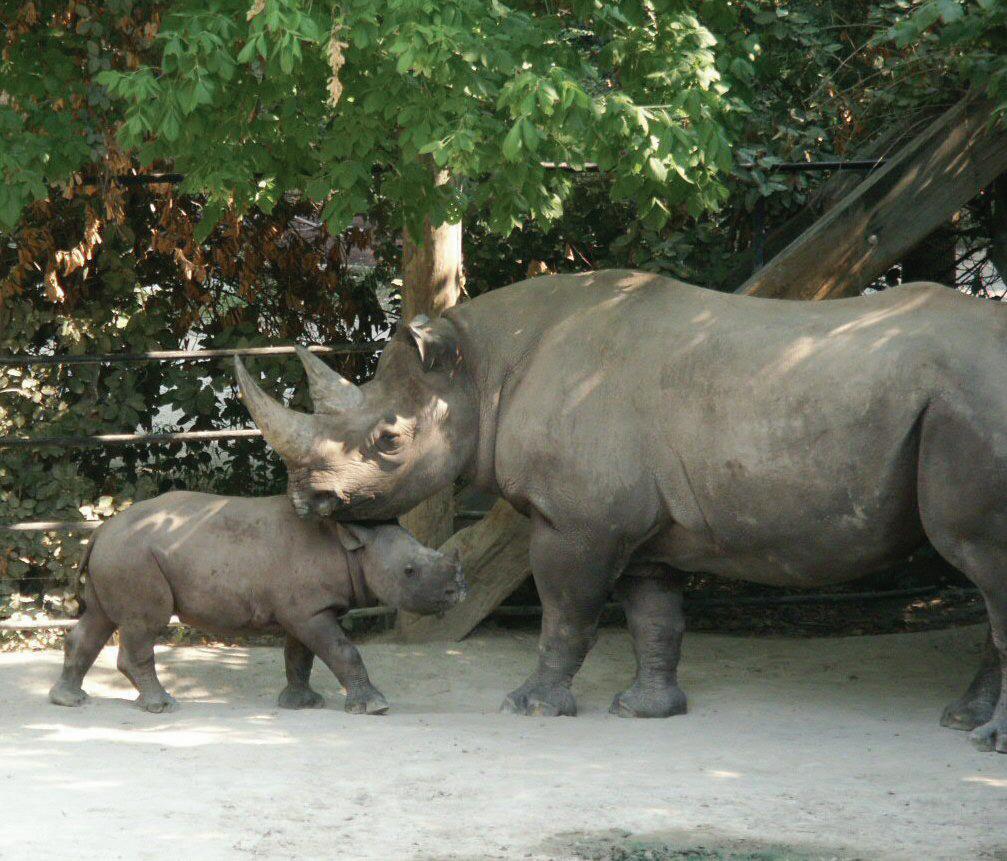
Black Rhino with Juvenile

Nile Breweries’ CSR Environmental Efforts
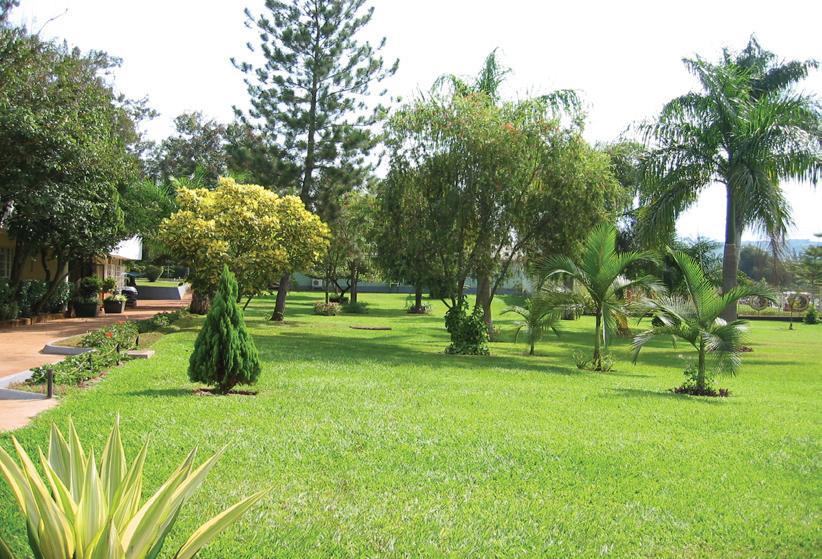
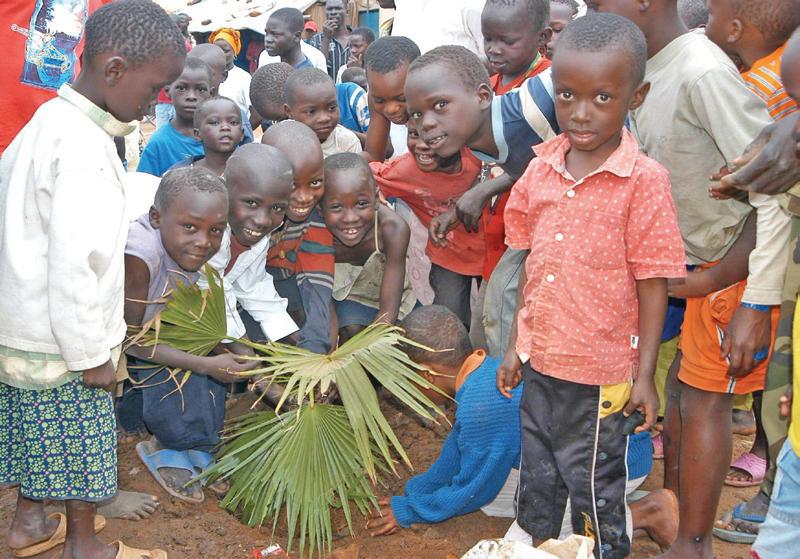
Nile Breweries Limited (NBL) is a subsidiary of SAB Miller-South Africa. As part of its Social Corporate Responsibility, NBL adopted sound environmental management, both at the company’s headquarters in the eastern Ugandan district of Jinja and in the communities that we directly work with around the country.
ACTIVITIES: NBL Gardens: At NBL, we value the environment we operate in and strive to make the surrounding as pleasant as possible for our employees. We therefore maintain our gardens to high standards. The objective is to make the atmosphere pleasant and relaxed taking off some of the pressures of the work place. At the moment, we are working on a water recycling project that will provide water for the gardens and reduce our water consumption levels. Oil Spillage: On occasions minor oil spillages occur at the brewery which get into the drainage system. This oil usually comes from the machinery we use at the brewery. To remove the oil from the water, we use a specially designed oil trap. The oil floats on the water and is removed manually. Only then is the water discharged from the brewery.
Glass Recycling: As part of NBL’s desire to ensure sound waste management standards by recycling waste, we negotiated with our glass bottle supplier to take back all broken glass so that it can be reworked. All glass breakages are measured on a shift basis and we have also managed to put in place very many measures to reduce the bottle breakages.
Reduction of NBL’s Carbon Footprint: Nile Breweries is also committed to reducing

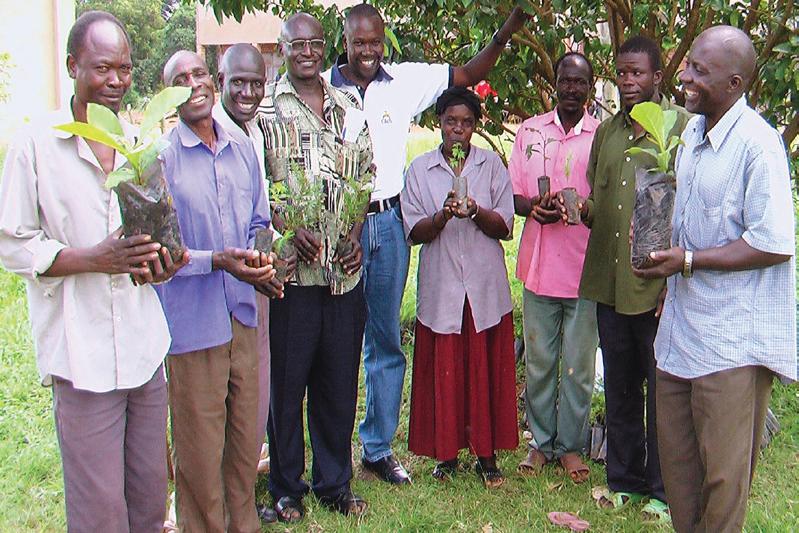

Nile Breweries’ CSR Environmental Efforts Nile Breweries’ CSR Environmental Efforts
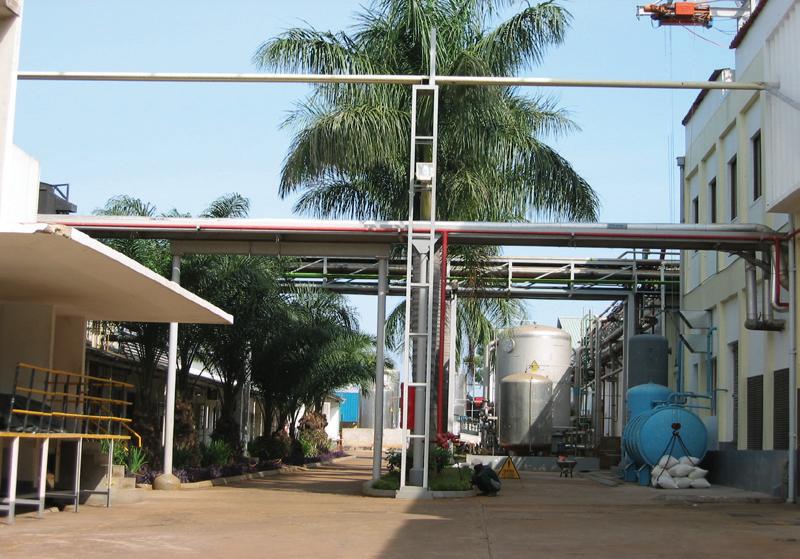


its carbon footprint through proper harvest and re-use of CO2 during the brewing process. NBL has distributed tree seedlings through its afforestation programme among its sorghum farming communities especially in eastern and western Uganda districts. Although this afforestation programme is relatively new, we believe it will go a long way in contributing to NBL’s carbon footprint.
The Green Towns Project: Recently launched, the multi- million shillings treeplanting campaign is to be implemented in all major towns across Uganda. Inaugurated in July 2008 in the West Nile district of Arua where over 50 palm trees were planted along the streets of the municipality, Nile Breweries was prompted to start the initiative due to the increasing use of concrete and lack of green open spaces in towns. The brewery will work jointly with municipal and city authorities as well as the communities in the towns to create greenery along major streets given the fact that most Ugandan towns are heavily exposed without good vegetation, trees, hence the dusty neighborhoods in the towns. The beauty of trees is that they do not only absorb dust but also stabilize road reserves, and when it rains, they reduce floods. But above all, trees make the towns look beautiful. The project has also been designed in such a way that children below 10 years feature prominently in the planting of trees. This is a deliberate gesture of not only incorporating them in the project but also inculcating the spirit of environmental management in them. The towns on the immediate roll out plan include Gulu, Mbarara and Kabale and they will receive up to 200 trees depending on the length of the streets and avenues to be covered.


from pg 18 • To recover all areas with high soil erodibility and steep slopes. • To consolidate the areas recovered above to avoid fragmentation, to streamline boundaries and to facilitate forest management. • To minimize the number of households to be resettled in the same excised forest area.
Benefits and Impacts
• Over 4,000 Ha of excised land with a good forest cover will be recovered. • Over 13,100 Ha of excised land around the top of the Mau Escarpment with high catchment values will be recovered. • Reduction of soil erosion and siltation of lakes and rivers. • Forest land consolidated; boundaries streamlined. • Some 6,700households will need to be resettled.
A majority of them can be resettled in the excised areas with low settlement density depending upon the resettlement policy regarding the area allocated per household.
South West Mau:
The situation in South West Mau differs substantially from Eastern Mau. • There are no large tracks of forest in the excised area that can be recovered. However there are some isolated valuable forest plantations along the boundary between the excision and settlements. • The excised areas have a medium to high settlement density. • Some 2,300 households were recorded encroaching illegally up to 10 kilometres inside the remaining gazetted forest reserve. • The excised areas are further away from the top of the Mau Escarpment. • There are steep river valleys that cross the excised areas. • The excised area forms an important part of the upper catchment of Sondu river and is likely to impact negatively on the lower catchments and the Sondu-Miriu hydropower plant currently under construction.
Suggested way forward
• There is urgency in evicting all illegal squatters in the remaining gazetted forest reserve and in monitoring the situation periodically. • There are no clear opportunities to recover forests from the excised areas and conserve those critical upper catchments without evicting a substantial number of people. • There is need to boost agro-forestry practices in the excised areas and to promote terracing in the steeper river valleys to conserve the catchment value of the area.
from pg 6 Change in rainfall patterns
The report notes that the rainfall
patterns have become erratic and destructive. According to Oxfam, the changing weather pattern is caused by pollution, especially by gases from industries. “Most of the current warming is being driven by outpouring of green house gases from coal, oil and gas that powered the industrial revolution in Europe and the US 150 years ago,” the report notes. “We all witnessed first hand the devastation caused by the floods and landslides last year, and scientific experts warn that with the current change in climatic conditions, this is just the beginning of these sorts of natural disasters,” says Savio Carvalho, Oxfam Country Director in Uganda. He adds: “Rich nations must cut their greenhouse gas emissions, but unless poor countries increase adaptation efforts, we are likely to see increased deaths and displacements due to hunger, floods and landslides as well as epidemics as a result of climate change.”
The report observes that farmers in Uganda need to learn new practices to adapt to new climatic changes, showing that adaptation can help the communities live with the climatic change that has taken its toll on farming and pastoral communities. It says farmers like Mbejuna are struggling hard to cope and calls for natural resources management. “Development cannot be sustainable unless the Government takes natural resource management seriously.”
The report launched by Vice-President, Prof. Gilbert B. Bukenya at Theatre Labonita in Kampala, calls for urgent measures to be taken to prevent land degradation and restore lost wetlands, forests, water bodies and other ecological systems.
Oxfam calls on the government to speed up the process of adapting to climate change by immediately implementing the National Adaptation Programmes of Action.
“There is more erratic rainfall in the March to June rain season, bringing drought and reductions in crop yields and plant varieties.
“Then the rainfall towards the end of the year is more intense and destructive, bringing floods, landslides and soil erosion. If temperatures rise too far, Uganda’s coffee crop is in danger of extinction,” notes Oxfam. Effects on MDGs
Oxfam believes that increasing people’s capacity to adapt to climate change will achieve a double benefit, by also contributing to the goal of overcoming poverty and suffering in Uganda and achieving the Millennium Development Goals by 2015 (MDGs).
During the research, Oxfam visited several parts of the country listening to poor men and women who have borne the brunt of climate change effects. From the natural disaster-prone areas of the Rwenzori region to the drought-hit areas of Karamoja, rural and urban people described how their livelihoods and traditions face serious threats and even possibly ultimate extinction. The lead researcher on the report, John Magrath, says climate change is really happening and makes life more difficult for the poor. “There is need for concerted efforts from government authorities, local leaders and policy makers as well as civil society.
These include environmental measures to reduce deforestation and restore wetlands, as well as measures to reduce poverty, like providing basic services like health and water, investing in agriculture and strengthening pastoralism through ensuring mobility,” he notes
George Kampamba, WWF International’s African Rhino Programme Coordinator.
Although WWF has worked on Rhino conservation throughout its 45-year history, the ARP was notable for its overall approach. Working through field projects, it combined action at every level from local communities to global policy.
One striking, if unanticipated, indicator of the success of the programme is that land prices immediately increase in areas where rhinos are re-introduced through a range expansion program.
The ARP, which has had experience reintroducing rhinos to national parks, also passed a milestone last year when a KwaZulu Natal community received black rhinos for community-owned land dedicated to wildlife and ecotourism uses.
“Rhino conservation in Africa is growing from strength to strength. But poaching, illegal trade, and unplanned development remain significant problems across the rhinos’ range and there is no room for complacency”, according to the conservationist, said Dr Susan Lieberman
CLIMATIC CHANGE AND THE PLIGHT OF YOUTH IN UGANDA
By Daniel Omodo - McMondo
Background
Climatic change is variably defined by different people but for this purpose it refers to a variability in long term weather conditions/ patterns (climate) resulting from changes in the composition of global atmosphere.
Climatic change is a global phenomenon and is due to increased retention of radiant energy in the atmosphere due to increase of Green House Gases (GHGs) especially carbon dioxide (CO
2) and methane (CH4) in the atmosphere as a result of natural processes to a lesser extent and anthropogenic (human–induced) activities to a major extent. Studies reveal increasing trends in temperature, green house gases and sea levels. Global surface temperatures have increased at a rate near 0.06°C/decade but this trend has increased to a rate approximately 0.18°C/decade during the past 25 to 30 years, and 11 of the warmest years in the past 125 years occurred since 1990, with 2005 having been the warmest year. Atmospheric CO2 concentration has remained below 300 ppm for the past 600,000 years but is now at 380 ppm and rising. Sea levels showed the fastest recorded rise at 4mm per year in the 1990s and future increases are likely to be similar or greater, while longer term increases in sea level may surpass 1m per century.
The Intergovernmental Panel on Climate Change in its Third Assessment Report (TAR) concludes that human activities are the main contributors to global warming. The Fourth Assessment Report confirms the TAR and provides clear policy guidance for actions now.
The major human contributors to climatic change include combustion of fossil fuels in engines of a variety of industries (including transport and energy production) at an increasing rate yet these fossil fuels took millions of years to form); deforestation (mainly for energy production); agricultural production (animal rearing, rice cultivation, poor agricultural practices, etc.); and pollution (from industrial and municipal waste decomposition) among others.
The least developed countries like Uganda are particularly vulnerable to adverse effects of climate change despite the fact that they contribute far much less GHGs than the developed countries.
On the other hand, Youth in Uganda, like many other countries of the world, are defined as all young persons between the ages of 18 to 30 years according to the National Youth Council Statute 1993 and The 1995 Constitution of Republic of Uganda. Youth and young people constitute 78 per cent of Uganda’s population which is about 27 million people (Population Census, 2002).
Climatic change problem and the youths in Uganda
As a result of climatic change, there have been several problems namely:- • Accelerated melting of ice on mountain tops (Mountain Rwenzori), which could rise sea
levels, flood coastal plains and cities (where a large fraction of the human population lives and works), thus heightening the problem of water insecurity. • Floods and droughts due to climatic change lead to contamination of water sources, water borne and respiratory diseases. There has been increased pollution of water resources both in urban centres and rural areas as well as serious problems of sanitation, particularly in slums. • Floods and droughts are leading to increased water scarcity in semi-arid areas such as Teso and
Karamoja. • Increased exposure to extreme weather events and the increased energy lingering in the earth system has resulted into more violent storms, land slides and collapse of infrastructure and ecosystems.
Disruption of transport infrastructure such as washing away of bridges cuts off populations, the majority of which are youth from accessing social basic services.
• Increased warming could escalate temperature extremes, floods, and droughts thus reducing agricultural productivity. Coffee, which is a major export earner in Uganda, is a fragile crop that is already showing negative signs due to Climatic
Change. The cattle corridor is prone to droughts despite having the highest animal population.
This has led to high pressure on land resources leading to serious land degradation from both grazing animals and pastoralists looking for fuel wood thus causing severe soil erosion during heavy rains.
In Uganda, the youths are regarded as a marginalized group of the population that is faced with several challenges including;
• High levels of poverty among the youths directly linked to their high dependence on adults and high levels of unemployment. The Uganda
Poverty Participatory Assessment Project (UPPAP) report of 2000 categorised the majority of the youths among the poor and vulnerable people in Uganda. The youths have a limited access to factors of production due to their lack of ownership of collateral.
• This problem is further exacerbated by the high population growth rate (3.4%) in
Uganda. • Youth unemployment in Uganda is still unacceptably high. Recent studies by the
Ministry of Gender Labour and Social
Development indicate that about 380,000 youths are released in the job market each year to compete for the estimated 90,000 jobs available representing an unemployment rate of about 76 per cent. The frustration of unemployment has resulted into high crime rate and in some cases insecurity in some parts of the country. • The long instability in some parts of the country notably northern Uganda and
Karamoja has disrupted normal economic activities of the people, most youths become both victims and perpetrators of violence, and as a result, most of the youths have ended up in prison, while others migrated to urban areas hence limiting their ability to engage in meaningful developmental activities including planning and decision making processes back home. • Reliable sources have reported that the main challenge to the implementation of the World Programme of Action on
Youth in Uganda has been financial constraints. The budgetary supply towards the ministry responsible for the youths has not been commensurate to the volume of work and the expectations of the youths.
Consequently, most of the planned youth programmes remain unimplemented. youths in Uganda include;
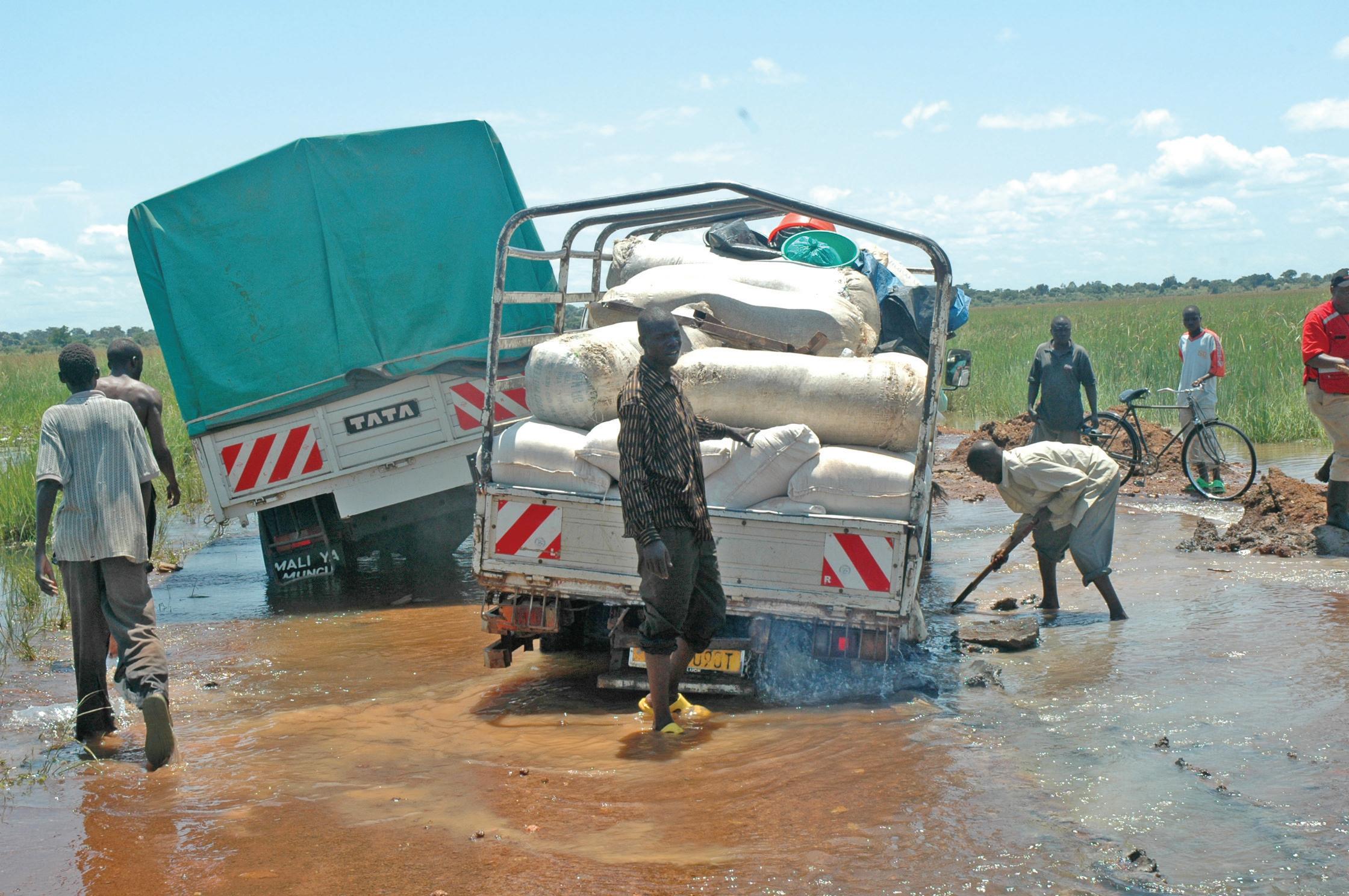
• Youths are the majority and thus most affected by the negative impacts of climatic change in Uganda. • Climate change can induce poverty thus exacerbating the already high poverty levels among the youths. This is critical as it could limit youths from accessing basic social services such as food, shelter, education, health, water, sanitation, transport, communication and energy among others thus rendering them highly vulnerable to other climatic change induced impacts. Put differently, lower yields mean less food and more hunger. More illness is also linked to seasonal climatic variations, with malaria cases, for example, shooting upwards in the rainy season. Oxfam (2008) further reported that Ugandans cite illness, with the consequent inability to work and the costs of seeking medical treatment, as the main immediate reason for falling into poverty.
Uganda is a signatory to the United Nations Framework Convention on Climate Change (UNFCCC), which provides the framework for mitigating causes of climate change and its effects. The ultimate objective of this Convention and any other related legal instruments that the Conference of the Parties may adopt is to achieve, in accordance with the relevant provisions of the Convention, stabilization of concentrations of greenhouse gases in the atmosphere at a level that would prevent dangerous anthropogenic interference with the climate system. Such a level should be achieved within a timeframe sufficient to allow ecosystems to adapt naturally to climate change, to ensure that food production is not threatened and to enable economic development to proceed in a sustainable manner.
Under the UNDP Global Strategic Plan 200811, UNDP’s climate change strategy has four pillars namely;
1. Assist developing countries (including
Uganda) to meaningfully contribute to development of post-2012 climate regime. 2. Increase capacity of developing countries to adapt to climate change. 3. Create market conditions for sustainable development and climate change mitigation. 4. Mainstream climate change into UNDP core activities, as well as relevant UN activities and programmes.
Mitigation of green house gases
The UNFCCC recognizes the contribution of developed countries to the build up of greenhouse gases in the atmosphere and therefore commits these countries to do more. The convention committed developed countries to reduce their greenhouse gas
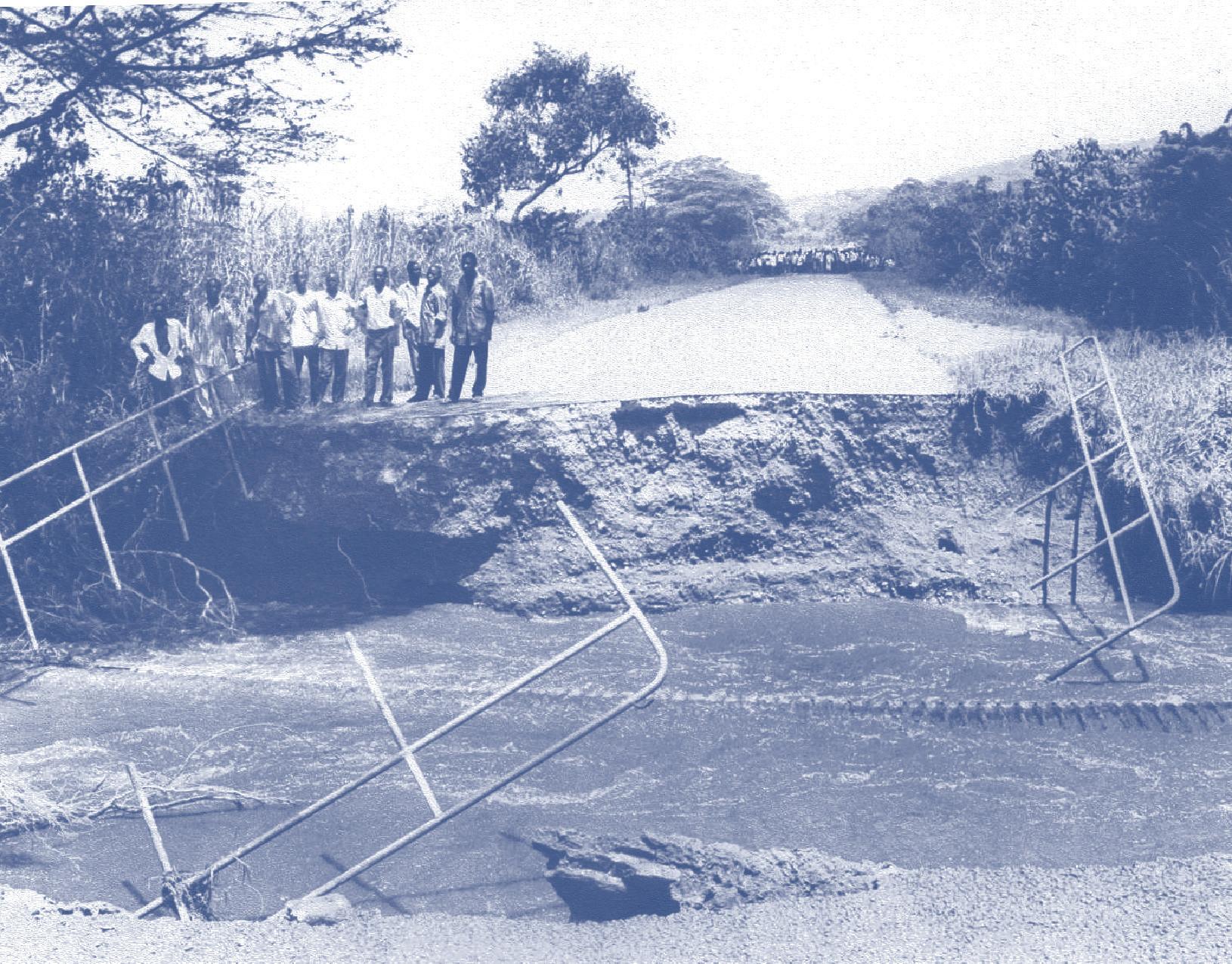
emissions to the 1990 level by the year 2000 but not many complied with this commitment. Parties to the Kyoto Protocol will now have no option but to comply with their greenhouse gas emission reduction commitment.
Adaptation to climate change
Adaptation is built into the objective of the UNFCCC that is to lower climate change risks in developing countries so as to attain the MDGs. Such a level should be achieved within a time-frame sufficient to allow ecosystems to adapt naturally to climate change, to ensure that food production is not threatened and to enable economic development to proceed in a sustainable manner.
An example of global initiatives for Climatic Change adaptation is the UNDP UNEP Climate Change and Development Adapting by Reducing Vulnerability (CC DARE) initiative focussed on providing technical backstopping and seed funds for capacity building for climatic change adaptation in Uganda.
Implementation of the UNFCCC in Uganda
The Ministry responsible for Environment through the UNFCCC National Focal Point Office which coordinates the issues of climate change and implementation of climatic change activities has drawn on and integrated expertise from other line ministries: • Preparation of Initial National Communication involved; inventory of greenhouse gas emissions and removals, identification of vulnerable sectors and adaptation options and identification of measures, which could be given resources, • Technology Needs Assessment, • Preparation of the National Adaptation Programmes of Action (NAPA), which included; identification of urgent and immediate interventions to minimize negative impacts of climate change on rural communities including; community tree planting, land degradation management, strengthening meteorological services, community water and sanitation, water for production, drought adaptation, vectors, pests, disease control and; climate change and development planning. • A conceptual framework for implementing the NAPA is near completion
Uganda has actively participated in and is a signatory to several Climatic Change related agreements namely: • The 2005 Climate Change Meeting in Montreal which established two processes namely an Ad Hoc Working
Group to negotiate commitments for developed country
Parties to the Kyoto Protocol for the second commitment period and beyond – output legally binding and a dialogue on long-term cooperation action to enhance implementation of the convention – no output (knowledge among others.
Ugandans have lived with disasters such as floods and droughts for a long time and have developed some coping mechanisms which are localized. However, these should be developed and popularised. For instance Ugandans use wild food including leaves, stems, fruits and yams as well as storage preservative facilities/technologies e.g. granaries and honey are used in times of droughts and also migration to higher ground or highlands, use of boats, floating materials and sometimes tree climbing to cope with heavy floods.
– improved understanding). • The Bali Convention of 2007 had a key outcome to develop an AWG with a clear time table to conclude negotiations for the second commitment period and beyond by 2009 and the Bali
Action Plan, which was the most significant political outcome focusing on: mitigation, adaptation, development and access to technologies, financing, reduced emissions from deforestation and degradation focussed on capacity building to enable quantification of compensation. An Adaptation
Fund including negotiations on Governance structure and modalities for accessing funds were completed, a Board established and
Members of the Board elected. The
Global Environment Facility (GEF) was invited to serve as Secretariat to the Board and Trustee of the fund respectively.
The Republic of Uganda recognized 25EnviroConserveAFRICA Aug/Oct 2008 that youths present an opportunity for a sustained effort to participate in the country’s development process because they constitute the majority (78%) of the population, posses greater energy, workforce and potential. Through the Ministry of Gender Labour and Social Development, the Department of Youth has spearheaded policy formulation, standard setting, quality assurance and training of youth in Several projects to address climatic change have and continue to be implemented in Uganda, with support from development partners such as the World Bank, UNDP, UNEP, Norway and DFID among others for instance the tree planting micro projects under the UNDP/GEF Small Grants Programme and UNEP Multi Lateral Agreements Project and the National Disaster Risk Policy that also focuses on climate change funded by UNDP
the country. The National Youth Council, established by an Act of Parliament in 1993 opened further avenues for the youths to take part in decision-making processes at all levels of governance.
The Constitution of Uganda provides for affirmative policy for the youths through their representation in the national assembly by five MPs and at each district local councils by two youth councilors. The government formulated and implemented the National Youth Policy in 2000 to provide guidance on the implementation of youth empowerment programmes in the country with a mission of “youth empowerment through education, training and capacity building.”
The youths being among the poor people in Uganda, are targeted as a group by the Poverty Eradication Action Plan (PEAP), now being revised into a National Development Plan, the Plan for Modernisation of Agriculture (PMA), Social Development Sector Investment Plan (SDIP), which promotes issues of social protection, gender equality and equity and human rights of the poor and vulnerable and emphasizes mobilization of communities to participate in development programmes and demand for services accountability; reduction in inequality and exclusion; creating enabling environment for increased employment opportunities; protection of vulnerable persons from deprivation and livelihood risks as well as gender mainstreaming in other sector plans.
Other sector wide approaches and plans that have attempted to mainstream the youths include Environment and Natural Resources Sector Investment Plan (ENRSIP), Health Sector Strategies Plan (HSSP), Education Sector Investment Plan (ESIP) and Justice, Law and Order Sector Plan (JLOSP) among others.
Poverty eradication programmes and activities are implemented through a decentralized framework. Local governments determine local development priorities, plans and budgets and implement local programmes using conditional, unconditional and equalisation grants as well as locally generated revenue.
There are now several projects targeting youths at the national and local levels.
Conclusion
In conclusion, climate change is real and it is beginning to negatively impact on Uganda’s ecological, social-economic and political environments including the youths. Having good plans and budgets is not good enough, the best thing to do is to act now through practically implementing such plans and budgets into on-the-ground activities to avoid the negative impacts of climatic change that increasingly face man kind particularly the youths who have a bigger stake in the future.
Some recommendations on climatic change and youths for Uganda
• Preparedness is more important to mitigating negative impacts of climate change as evidenced by Hurricane Katrina and the resulting disaster (USA). Ugandans like other countries must develop mechanisms to mitigate and cope with negative impacts of climate change. Indigenous technologies exist but these need improvement and enhancement
• Adaptation technologies are area specific and therefore south to south adaptation technology transfer makes more sense.
Promotion of cooperation in this area should be supported especially coping with effects of droughts and floods.
• The Government of Uganda with the assistance of its development partners urgently needs to:
(a) Assess vulnerabilities in key sectors (including the Youth Sector); (b) Integrate climate change risks into Poverty
Reduction Strategic Plans such as the
NDP at national level as well as Local
Government and Community Development
Plans; (c) Access funding to support adaptation.
• In addressing climate change and its negative impacts, the Government of
Uganda should create an enabling environment for organized people such as private companies, faith based organizations, community based organizations, NGOs, local councils and schools, which hold the key to addressing the climatic change problem in Uganda.
• There is need to support national disaster risk assessments, including those related to climate change.
• There is need for Ugandans particularly the youths to develop new approaches to stimulate markets plus payments for environmental services and projects under the Cleaner Development Mechanism (CDM) for GHG reduction. Ugandans should exploit the available opportunities, such as the MDG Carbon Facility among others to identify and develop projects, mobilize co-finance, facilitate project approval, realize Carbon Emissions Reductions (CERs), and support project implementation.
As a first step to Climatic Change adaptation, there is need to build capacity of all stakeholders particularly the youths at all levels through:
• Awareness rising on actual and expected climate changes at national and local level, their likely impacts and appropriate adaptation efforts with youths’ participation. • Analysis of climate sensitive areas that are critical to the achievement of key development objectives in Uganda, and development of a roadmap for integrating climate change vulnerabilities particularly those affecting the youths. • Analysis and quantification of key links between climate change impacts and adaptation options with general development goals. • Build capacity for climate screening of activities in different sectors including the youth sector. • Develop and test a simple tool, i.e. climate screening module, for planning of major investments, for instance, infrastructure (roads, buildings, bridges, dams, and rail) including their maintenance in relation to youths and other vulnerable groups. • Design and test a format for incorporating climate vulnerability in the new NDP. This format should include relationships between development and climate vulnerability for the different pillars of the NDP. • Identification of climate change sensitive short, medium and long term activities in major sectors (including the youths, energy and infrastructure sectors) of Uganda, and assessment of vulnerabilities in relation to specific projects.
Daniel Omodo – McMondo is a Programme Officer (Environment) in UNDP Uganda Country Office
The Cheif Guest Prof. Tarsis Kabwegyere (fore ground), the minister for Relief and Disaster Preparedness inspects stalls at this year’s World Population Day celebrations at Kakyeka stadium, Mbarara Municipality (Courtesy photo)

Stopping Uganda’s population growth
At the current rate, Uganda’s population grows at an annual rate of 3.2 percent, one of the highest in the world. However, reproductive health experts say family planning can bring about a quality population, Ronald Musoke writes.
Although Uganda’s President Yoweri Museveni always reminds everyone who cares to listen that the country’s rapidly growing population is a blessing; experts argue that it depends on a number of factors, the quality of the population being one of them.
There are definitely some advantages that can be harnessed from big populations. Economies of scale can be reaped from big populations whereby larger markets are provided for goods and services, a big labour force that can be tapped on to provide specialized services and not least of all benefits of open markets and free trade. This view has long been held by President Museveni who sees opportunities in Uganda’s rapid population growth.
“A country’s population is its most important resource and asset. The wealth of a nation is not in the soils and stones in the ground. It is in its people, its population”, Museveni said recently in his speech read by Prof Tarsis Kabwegyere, the Minister of Relief and Disaster Preparedness at Kakyeka Stadium in Mbarara district where national celebrations for World Population Day were held on July11.
However, other people argue that Uganda’s growing population will create opportunities only and only if it is healthy and trained. Rapid population growth impacts on many aspects of our lives: health, education, water, food, employment and the environment, says Stella Kigozi, the Senior National Programme Officer at Population Secretariat.
On health, she says that as the population grows, so does the demand for health care. This means that more funding is required. In many developing countries, health care is already stretched to the limits; just over half of all births in these countries take place without a skilled doctor, nurse or midwife.
Population and Environmental Quality
The UNFPA says that about half of the earth’s biological production capacity has already been diverted to human use. Life supporting eco-systems are affected everywhere by the planet’s 6.7 billion people which is projected to reach at least 9.2 billion by 2050.
The UN population agency says humans are depleting natural resources, degrading soil and
Background
SGS Environmental Services is a global service division of SGS which currently operates worldwide and has nodes of operation in Ghana, Kenya, Tanzania, and South Africa, specializing in many environmental services like air quality monitoring, Environment Impact Assessments (EIAs), Soil and Water testing, Soil Impact Assesments (SIAs), Environmental audits and environmental baseline studies.
SGS is the world’s leading inspection, verification, testing and certificationcompany.We are recognized as the global benchmark for quality and integrity. With more than 48,000 employees, SGS operates a network of 1,000 officesandlaboratoriesaroundthe world. SGS Ecoserv. Before the merger, ECOSERV was the firstoperator in Africa to achieve ISO Guide 25 (now ISO 17025) for its ambient air monitoring service in 1999.It was also responsible for introducing realtime, database-centric monitoring networks that put data in the hands of its customers. Since then, SGS Ecoserv has delivered cost-effective monitoring solutions for global businesses intent on meeting increasingly stringent air quality objectives. Comprehensive data sets, demanding quality objectives and dedication to delivery are the hallmarks of our service.

SGS Services
Emission Testing
Applying US Environment Protection Agency methods to the testing of emissions from a range of industrial facilities and sources, our teams use proprietary equipment that allows precise measurement to the most demanding standards. Our reports have been used for design purposes by Africa’s largest industries, compliance reporting for international lenders, national governments and international environmental performance reporting.
Ambient Air Testing
In 2007, ECOSERV and SGS South Africa joined forces to create one cohesive environmental service group for Africa called
Dust Deposition Monitoring
Specialist subsidiary Annegarn Environmental Research (AER) focuses on the assessment of medium-term trends in dust management in the vicinity of mines and metallurgical facilities. With over 1,000 monitoring points reporting dust concentrations on a monthly basis, AER’s customers’ long term databases provide confidenceintheeffectivenessof environmental control mechanisms.
Occupational Hygiene
Good occupational hygiene control provides protection to employees from hazards in the work place. SGS Ecoserv provides a risk assessmentto- validation data service intended to provide our customers with confidenceintheirmonitoringand systems.
SGS Environment Services in Africa SGS Environment Services in Africa WHEN YOU NEED TO BE SURE
Monitoring Services include specializations in noise, heat, gas, and dust, asbestos and ergonomics. SGS Ecoserv is an Approved Inspection Authority, recognized by the South African Department of Labour.
Environmental Permitting/ Environmental Impact Assesment/Environmental Impact Statement
Permitting or certification of developments is a regulatory tool used by government or other stakeholders for the protection of ecological and human environments. Permits can specify both general and particular operating requirements.
Permits are typically granted following an Environmental Impact Assesment (EIA) and the preparation of an Environmental Impact Statement (EIS) detailing both the benefitsandimpactsofa development. The EIS includes a detailed description of the social impact aspects of the development. Since 1994, SGS Environment has undertaken over 400 environmental impact assessments and accompanying reports.
The assessments have been undertaken in a number of African countries including Botswana, Burkina Faso, Ivory Coast, DR Congo, Ghana, Guinea, South Africa and Tanzania. All the assessments have involved the use of national consultants in the respective countries and in some instances co-operation with other international environmental consultants.
Social Baseline Surveys
International organizations and associations such as the ICMM (International Council on Mining and Metals), the World Coal Institute and the World Business Council for Sustainable Development (WBCSD), and multi-laterals, such as the World Bank and International Finance Corporation (IFC), now more than ever recognize the importance of providing guidance to improve the contribution of extractive industries to the sustainability of communities.
Major banks around the world have also set the ‘Equator Principles’ to determine if projects that they may financewillbedevelopedand operated in a socially responsible and rewarding manner. The key to improving contributions to sustainability and enabling social responsibility is to begin a social baseline survey at the very earliest stages of a development. SGS Environment has wide experience in undertaking social baseline surveys, especially in the West African mining industry. It has collected basic data on demographics, number of affected people, local and regional facilities, the local economy, education levels and health status among others.
Soil and Groundwater
SGS Ecoserv also provides soil and groundwater monitoring and analytical programmes aimed at characterizing sub-surface facility conditions as part of due diligence and on going risk management projects.
Water Monitoring
In many regions of Africa, water bodies are potentially both a receiver and a major transport medium for contaminants from industrial and domestic sources. Working closely with its laboratories, SGS Environment provides a sampling and analysis service to monitor water quality in urban, industrial and mining scenarios. Contaminant identificationandconcentrationisa prerequisite to successful treatment, whether before or after entry into the receiving environment.
Data has been used to determine baseline water quality for new industrial operators and mines and to assist in the management of effluentdischarges.Customers include mining companies, industrial operations, hotels and residential developments and investors.
The range of environmental solutions offered includes, ambient and indoor air sampling, stack emission sampling and continuous emission monitoring, indoor and environmental noise measurements, occupational health (work-place hygiene), water and waste water sampling and analysis, contaminated site/soil sampling and analysis, dioxin sampling, ISO 14001 cerificationandtraining,ISO18001/ OHSAS training and certification.

